Phil Plait: What Happens to a Werewolf on the Moon? “The transformation wouldn’t last a mere terrestrial night but an entire lunar day, which is two weeks in duration. The carnage would be literally unearthly.”



This site is made possible by member support. 💞
Big thanks to Arcustech for hosting the site and offering amazing tech support.
When you buy through links on kottke.org, I may earn an affiliate commission. Thanks for supporting the site!
kottke.org. home of fine hypertext products since 1998.
Entries for October 2023
Stop, Before You Close This Tab (or Any Others)… “Think of your browser like an ongoing autobiography. Why would you ever delete it?”
The History of the Electric Guitar Solo
YouTube channel Polyphonic (whose videos I’ve featured before) has taken on an ambitious project: tracing the history of the electric guitar solo from its origins in blues and country music in the American South all the way up to the present day. The series is called Axe To Grind and the first three episodes are available on YouTube (the first two are embedded above). People are sharing their favorite early electric guitar players in the comments of the first video.
The series is also available on the subscription-only Nebula — episodes appear there first and the music excerpts are longer because Nebula doesn’t trample all over creators’ fair use rights like YT does. (via open culture)
Look, I’m tired of all things Trump too, but for some reason, but this improv of Lord of the Rings’ Sauron as Trump by Brennan Mulligan had me rolling on the floor. The cadence is perfect.
Fungi: Web of Life
Fungi: Web of Life is an upcoming IMAX documentary on mushrooms & their fungi brethren narrated by Björk and presented by Merlin Sheldrake.
Join acclaimed British biologist, Dr. Merlin Sheldrake, on a quest to find an incredibly precious blue mushroom, against the backdrop of Tasmania’s ancient Tarkine rainforest. Merlin will show us some the grandest and strangest organisms ever discovered, showcased through jaw-dropping time-lapse cinematography, in a landscape largely unchanged from the time of the dinosaurs. Fungi have important lessons to teach humanity about survival through cooperation. Indeed, these incredible lifeforms may hold the key to solving some of humanity’s most urgent problems. With millions more species to discover, our journey into the secret world of fungi has only just begun.
Sheldrake is the author of Entangled Life: How Fungi Make Our Worlds, Change Our Minds & Shape Our Futures.
In 1952, a group of three ‘stars’ vanished — astronomers still can’t find them. A photographic plate taken at 8:52 pm shows a cluster of three bright stars. In a plate at 9:45 pm, they’re gone.
The Main Problem With Pedestrian Deaths Isn’t the Pedestrians. “Our transportation infrastructure exists to tell drivers that they have pride of place on our roads and streets and that their convenience is more important than any other consideration.”
Trailer for Stamped From the Beginning
Based on the bestselling book Stamped from the Beginning: The Definitive History of Racist Ideas in America by Ibram X. Kendi (also available as a graphic novel), this documentary explores the mythology of American racism and how it still shapes the world today. The director is Oscar-winner Roger Ross Williams and in preparing for the film, he decided that only Black women would appear in it:
“When we started looking at historians and scholars, we came up with a long list. I noticed the pattern that most of the people doing the work around racism in America were Black women,” Williams told Netflix. “I asked them in pre-interviews, ‘Why do you do this work?’ And many of them said the same thing — that they had no choice. This was their experience and their life. And if they’re going to dedicate their life to something, it’s going to be about changing and understanding racism in America because they can’t escape racism in America. I said to everyone, ‘We’re going to have only Black women in this film.’ It was an important statement to make.
Stamped From the Beginning comes out on Netflix on November 20.
Artisans Cooperative is a member-owned marketplace for handmade goods. Looks like they are trying to be what Etsy was back in the day.
Lionel Messi has won his eighth Ballon d’Or award, given annually to the best football player in the world. Hard to imagine anyone beating that record.
The World’s Most Popular Painter Sent His Followers After Me Because He Didn’t Like a Review of His Work. Here’s What I Learned. This was really interesting re: “parasocial aesthetics”.
Time Lapse Video of a Massive Lego Build of The Great Wave off Kanagawa
Lego master Jumpei Mitsui spent over 400 hours building a 3D version of Hokusai’s Great Wave off Kanagawa out of 50,000 Lego bricks — you can watch a time lapse of the construction in the video above. The build was included at an exhibition of Hokusai’s work at the MFA in Boston:
In order to create Hokusai’s Wave in three dimensions, he made a detailed study of rogue waves and their characteristics. He also drew on childhood memories of waves near his family home at Akashi on the Inland Sea.
The video slows down to realtime in spots, so you can see how fast he’s actually building (quite fast). And you can also see the level of trial and error involved as he builds and then un-builds the waves until he’s happy with them. (via the kid should see this)
Is This the End of David Chang’s Momofuku Empire as We Know It? Some of my favorite meals have been at Momofuku joints, but I gotta say, “perhaps Momofuku will give us the next Tim Cook” is a pretty sick burn.
Boston Dynamics turned its robot dog into a talking tour guide with ChatGPT. “The ‘fancy butler’ is not the only persona Spot assumes […it] also takes on the personality of a 1920s archaeologist, a teenager, and a Shakespearean time traveler.”
Nile Rodgers & CHIC’s Tiny Desk Concert
Oh, this is a good one: disco, funk, and hip-hop pioneers Nile Rodgers & CHIC play some of the most rousing and joyful music ever witnessed on the Tiny Desk Concert stage / corner of the NPR office. Here’s what they played:
“Le Freak”
“I’m Coming Out”
“We Are Family”
“Get Lucky”
“Good Times”
“Let’s Dance”
Name a better six-song set. I’ll wait. (Ok, maaaaybe this one.)
See also Nile Rodgers Tells the Story of the Iconic Riff on Bowie’s Let’s Dance.
The surprising scientific weirdness of glass. “Glass is so much weirder than a very slow-moving liquid. […] The simplest explanation for how glass forms is that it’s a liquid that cools too quickly for those crystals to form.”
An Inspiring Message From General George Washington About Our Nation’s Destiny
In this SNL sketch featuring host Nate Bargatze as George Washington, the commander of the Continental Army gives a rousing speech to a group of his soldiers about…measurement systems. So good.
Also good from the same episode: a soul food cooking competition:
As Tressie McMillan Cottom says: “Every time he says ‘I’m sorry’, it gets funnier.”
I came up with a tiny snippet of code that will annotate gift links (no paywall!) from NY Times, Washington Post, and the Atlantic using pure CSS. You can see it in action here.
How Much Blood Is Your Fun Worth? “Mothers must ask their sons for pictures of open [classroom] windows because Americans own AR-15s, and they own them because they are fun.”
The Loneliest Road in Every State in America. Only about 200 vehicles travel on the 414-mile stretch of state route 11 in Alaska each day.
The Best of Japan’s Mundane Halloween Costumes for 2023
There are only a couple of things I like about Halloween: 1. Heidi Klum’s costumes (last year she dressed up as a worm), and 2. the relatively recent Japanese tradition of mundane Halloween costumes. From Spoon & Tamago and Nick Kapur (here too), here are a few of my favorite mundane costumes:

“Factory worker who wore a helmet all day”

“Person who was about to be late for work, but then their train got delayed and now they are taking their time since they got a proof-of-delay ticket from the station”
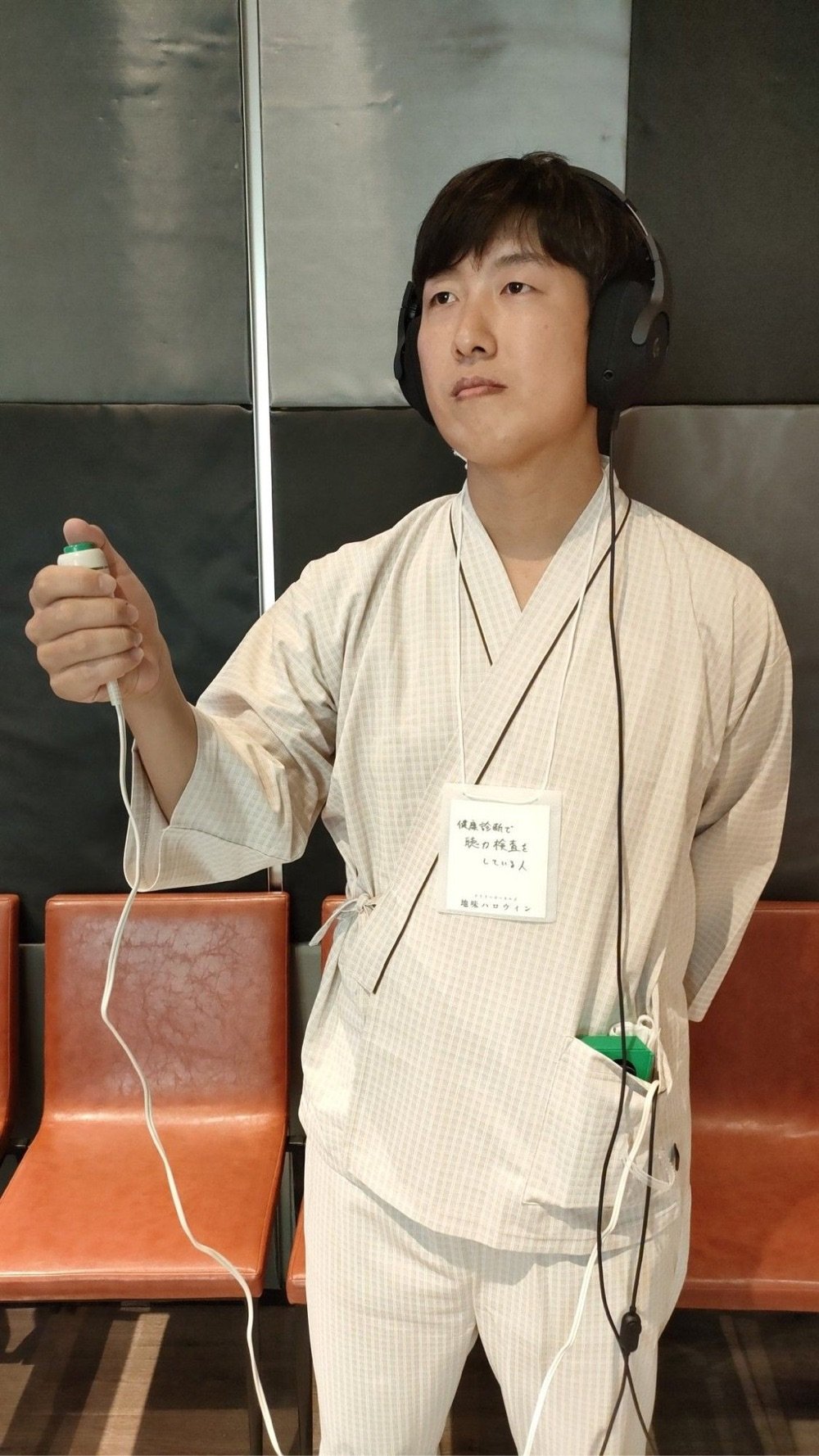
“Person taking a hearing test at the doctor’s office”
See also 2021’s best costumes, including “guy who leans in as his Mario Kart character turns a curve”.
I just found out that the original version of Tetris for the Game Boy is available on the Switch, so guess what I’m doing for the rest of the week?
I am…intrigued by this Bluetooth remote control that you can use to remotely scroll through TikTok or the Kindle app (and presumably less cool things like websites?) on your phone.
Feist and Hundreds of Choir Members Sing ‘Nothing Compares 2 U’ in Tribute to Sinéad O’Connor
Just hit play on this one and watch it. Absolutely magical…it sent shivers down my spine. The organization that arranged this is called Choir! Choir! Choir! and they also did a version of this in Dublin with 1000 people singing in tribute:
I’ve previously featured the group singing David Bowie’s Heroes with David Byrne, who said this of the experience:
What happens when one sings together with a lot of other people?
A couple of things I immediately noticed. There is a transcendent feeling in being subsumed and surrendering to a group. This applies to sports, military drills, dancing… and group singing. One becomes a part of something larger than oneself, and something in our makeup rewards us when that happens. We cling to our individuality, but we experience true ecstasy when we give it up.
(via open culture)
I enjoyed reading Ted Gioia’s list of 12 problems that he’s devoted his life to answering. Many of them go to the heart of how to lead a life of creativity and compassion, things which are often at odds in our culture.
From the looks of the teaser trailer, Poor Things is gonna be another Yorgos Lanthimos banger (The Lobster, The Favourite).
LIGO Has Surpassed The Quantum Limit. The gravitational wave detector’s sensitivity was bumping up against quantum uncertainties but they figured out a way around it called frequency-dependent squeezing.
Declassified Cold War satellite images reveal 100s of unknown Roman forts in Syria & Iraq. “The new discoveries instead point to the frontier being more fluid and a vibrant place of cross-border trade, rather than of constant violent conflict.”
Does Your Brain Picture Things?
A few weeks ago, I shared the following image on Instagram:

It’s a scale for measuring how people visualize objects in their heads. I’m between 4 & 5, which means I have a condition called aphantasia. Marco Giancotti recently wrote about this for Nautilus; he underwent an MRI scan to test what was going on in his head:
A few seconds pass, then a synthetic female voice speaks into my ears over the electronic clamor: “top hat.” I close my eyes and I imagine a top hat. A few seconds later a beep tells me I should rate the quality of my mental picture, which I do with a controller in my hand. The voice speaks again: “fire extinguisher,” and I repeat the routine. Next is “butterfly,” then “camel,” then “snowmobile,” and so on, for about 10 minutes, while the system monitors the activation of my brain synapses.
For most people, this should be a rather simple exercise, perhaps even satisfying. For me, it’s a considerable strain, because I don’t “see” any of those things. For each and every one of the prompts, I rate my mental image “0” on a 0 to 5 scale, because as soon as I close my eyes, what I see are not everyday objects, animals, and vehicles, but the dark underside of my eyelids. I can’t willingly form the faintest of images in my mind. And, although it isn’t the subject of the current experiment, I also can’t conjure sounds, smells, or any other kind of sensory stimulation inside my head. I have what is called “aphantasia,” the absence of voluntary imagination of the senses. I know what a top hat is. I can describe its main characteristics. I can even draw an above-average impression of one on a piece of paper for you. But I can’t visualize it mentally. What’s wrong with me?
And here’s a good video explanation of it too, from an artist who has aphantasia:
Like a lot of people, I wasn’t even aware that I visualized things differently than others — I assumed that everyone saw extremely ghostly images of objects in their mind’s eye, more like the ideas of things than the things themselves. It wasn’t until I was talking to my daughter a few years ago about how the characters in a movie looked nothing like the ones she’d pictured in her head from reading the books that I realized that she’s got a vibrant, full-color movie going on in her head when she reads and I was like EXCUSE ME?
Aphantasia is sometimes described as a deficiency or even a disability, but I don’t think of it that way at all. I believe my brain works pretty well, thank you very much, even though I can’t close my eyes and see the faces of my kids. And it’s not as straightforward as the simple scale above, at least in my case.
I can’t picture what a room would look like with a different sofa or rug (I just have to buy it and cross my fingers that it looks good when it arrives) or what a sweater would look like on me without actually trying it on (making online clothes shopping difficult). But I also have a weirdly visual memory. In college, I would remember things for tests and papers based where they were written in my notebook (lower right-hand corner of the left-hand page) or appeared in the textbook (on the right-hand page, under the blue illustration). I can’t see it in my brain, but I can see the idea of it and remember what was written there. (I told my daughter this and she said she can do this too, but for her, she pictures herself sitting at her desk in biology class with her notes open in front of her and she can then recall what was written in certain places. It is fascinating to talk about this stuff with her!)
Anyway, on Insta I asked people where they are on the apple scale and the responses were super interesting, so I’m opening up the comments on this one so we can chat about it.
So, You’ve Decided to Start Listening to Radiohead in Your Mid-Thirties. “Welcome, abandon all hope, smile, and settle into the uneasy feeling of being stuck somewhere between melancholy and smug satisfaction.”
I love these little ceramic ghosts. “High-fired ceramics has the ability to outlive us all. If you treat them respectfully, they will haunt you forever.”
Love this: a museum of internet artifacts, including the first email, Line Rider, an early Netflix website, Space Jam, and the first mp3. Some them are interactive — try signing on to AOL.
“From bacteria to blue whales, the number of cells in living things exceeds the estimated number of sand grains on Earth by a factor of a trillion. […] And the number of cells that have ever lived is 10 orders of magnitude larger still.”
How many animals have ever existed on Earth? The estimated number is ludicrously big, orders of magnitude more than a trillion. Mostly insects.
The United States of Guns
Like many of you, I read the news of a single person killing at least 18 people in Lewiston, Maine yesterday, which comes on the heels of many, many other mass shootings over the past four years. While these are outrageous and horrifying events, they aren’t surprising or shocking in any way in a country where more than 33,000 people die from gun violence each year.
America is a stuck in a Groundhog Day loop of gun violence. We’ll keep waking up, stuck in the same reality of oppression, carnage, and ruined lives until we can figure out how to effect meaningful change. I’ve collected some articles here about America’s dysfunctional relationship with guns, most of which I’ve shared before. Change is possible — there are good reasons to control the ownership of guns and control has a high likelihood of success — but how will our country find the political will to make it happen?
An armed society is not a free society:
Arendt offers two points that are salient to our thinking about guns: for one, they insert a hierarchy of some kind, but fundamental nonetheless, and thereby undermine equality. But furthermore, guns pose a monumental challenge to freedom, and particular, the liberty that is the hallmark of any democracy worthy of the name — that is, freedom of speech. Guns do communicate, after all, but in a way that is contrary to free speech aspirations: for, guns chasten speech.
This becomes clear if only you pry a little more deeply into the N.R.A.’s logic behind an armed society. An armed society is polite, by their thinking, precisely because guns would compel everyone to tamp down eccentric behavior, and refrain from actions that might seem threatening. The suggestion is that guns liberally interspersed throughout society would cause us all to walk gingerly — not make any sudden, unexpected moves — and watch what we say, how we act, whom we might offend.
We’re sacrificing America’s children to “our great god Gun”:
Read again those lines, with recent images seared into our brains — “besmeared with blood” and “parents’ tears.” They give the real meaning of what happened at Sandy Hook Elementary School Friday morning. That horror cannot be blamed just on one unhinged person. It was the sacrifice we as a culture made, and continually make, to our demonic god. We guarantee that crazed man after crazed man will have a flood of killing power readily supplied him. We have to make that offering, out of devotion to our Moloch, our god. The gun is our Moloch. We sacrifice children to him daily — sometimes, as at Sandy Hook, by directly throwing them into the fire-hose of bullets from our protected private killing machines, sometimes by blighting our children’s lives by the death of a parent, a schoolmate, a teacher, a protector. Sometimes this is done by mass killings (eight this year), sometimes by private offerings to the god (thousands this year).
The gun is not a mere tool, a bit of technology, a political issue, a point of debate. It is an object of reverence. Devotion to it precludes interruption with the sacrifices it entails. Like most gods, it does what it will, and cannot be questioned. Its acolytes think it is capable only of good things. It guarantees life and safety and freedom. It even guarantees law. Law grows from it. Then how can law question it?
Roger Ebert on the media’s coverage of mass shootings:
Let me tell you a story. The day after Columbine, I was interviewed for the Tom Brokaw news program. The reporter had been assigned a theory and was seeking sound bites to support it. “Wouldn’t you say,” she asked, “that killings like this are influenced by violent movies?” No, I said, I wouldn’t say that. “But what about ‘Basketball Diaries’?” she asked. “Doesn’t that have a scene of a boy walking into a school with a machine gun?” The obscure 1995 Leonardo Di Caprio movie did indeed have a brief fantasy scene of that nature, I said, but the movie failed at the box office (it grossed only $2.5 million), and it’s unlikely the Columbine killers saw it.
The reporter looked disappointed, so I offered her my theory. “Events like this,” I said, “if they are influenced by anything, are influenced by news programs like your own. When an unbalanced kid walks into a school and starts shooting, it becomes a major media event. Cable news drops ordinary programming and goes around the clock with it. The story is assigned a logo and a theme song; these two kids were packaged as the Trench Coat Mafia. The message is clear to other disturbed kids around the country: If I shoot up my school, I can be famous. The TV will talk about nothing else but me. Experts will try to figure out what I was thinking. The kids and teachers at school will see they shouldn’t have messed with me. I’ll go out in a blaze of glory.”
In short, I said, events like Columbine are influenced far less by violent movies than by CNN, the NBC Nightly News and all the other news media, who glorify the killers in the guise of “explaining” them. I commended the policy at the Sun-Times, where our editor said the paper would no longer feature school killings on Page 1. The reporter thanked me and turned off the camera. Of course the interview was never used. They found plenty of talking heads to condemn violent movies, and everybody was happy.
Jill Lepore on the United States of Guns:
There are nearly three hundred million privately owned firearms in the United States: a hundred and six million handguns, a hundred and five million rifles, and eighty-three million shotguns. That works out to about one gun for every American. The gun that T. J. Lane brought to Chardon High School belonged to his uncle, who had bought it in 2010, at a gun shop. Both of Lane’s parents had been arrested on charges of domestic violence over the years. Lane found the gun in his grandfather’s barn.
The United States is the country with the highest rate of civilian gun ownership in the world. (The second highest is Yemen, where the rate is nevertheless only half that of the U.S.) No civilian population is more powerfully armed. Most Americans do not, however, own guns, because three-quarters of people with guns own two or more. According to the General Social Survey, conducted by the National Policy Opinion Center at the University of Chicago, the prevalence of gun ownership has declined steadily in the past few decades. In 1973, there were guns in roughly one in two households in the United States; in 2010, one in three. In 1980, nearly one in three Americans owned a gun; in 2010, that figure had dropped to one in five.
A Land Without Guns: How Japan Has Virtually Eliminated Shooting Deaths:
The only guns that Japanese citizens can legally buy and use are shotguns and air rifles, and it’s not easy to do. The process is detailed in David Kopel’s landmark study on Japanese gun control, published in the 1993 Asia Pacific Law Review, still cited as current. (Kopel, no left-wing loony, is a member of the National Rifle Association and once wrote in National Review that looser gun control laws could have stopped Adolf Hitler.)
To get a gun in Japan, first, you have to attend an all-day class and pass a written test, which are held only once per month. You also must take and pass a shooting range class. Then, head over to a hospital for a mental test and drug test (Japan is unusual in that potential gun owners must affirmatively prove their mental fitness), which you’ll file with the police. Finally, pass a rigorous background check for any criminal record or association with criminal or extremist groups, and you will be the proud new owner of your shotgun or air rifle. Just don’t forget to provide police with documentation on the specific location of the gun in your home, as well as the ammo, both of which must be locked and stored separately. And remember to have the police inspect the gun once per year and to re-take the class and exam every three years.
Australia’s gun laws stopped mass shootings and reduced homicides, study finds:
From 1979 to 1996, the average annual rate of total non-firearm suicide and homicide deaths was rising at 2.1% per year. Since then, the average annual rate of total non-firearm suicide and homicide deaths has been declining by 1.4%, with the researchers concluding there was no evidence of murderers moving to other methods, and that the same was true for suicide.
The average decline in total firearm deaths accelerated significantly, from a 3% decline annually before the reforms to a 5% decline afterwards, the study found.
In the 18 years to 1996, Australia experienced 13 fatal mass shootings in which 104 victims were killed and at least another 52 were wounded. There have been no fatal mass shootings since that time, with the study defining a mass shooting as having at least five victims.
From The Onion, ‘No Way To Prevent This,’ Says Only Nation Where This Regularly Happens:
At press time, residents of the only economically advanced nation in the world where roughly two mass shootings have occurred every month for the past eight years were referring to themselves and their situation as “helpless.”
But America is not Australia or Japan. Dan Hodges said on Twitter a few years ago:
In retrospect Sandy Hook marked the end of the US gun control debate. Once America decided killing children was bearable, it was over.
This can’t be the last word on guns in America. We have to do better than this for our children and everyone else whose lives are torn apart by guns. But right now, we are failing them miserably, and Hodges’ words ring with the awful truth that all those lives and our diminished freedom & equality are somehow worth it to the United States as a society.
How to Officiate a Wedding. “I think of it as a storytelling event. You’re really just telling the love story of two people, and guests should sort of nod along but also discover things they didn’t know about the couple.”
The World’s Writing Systems
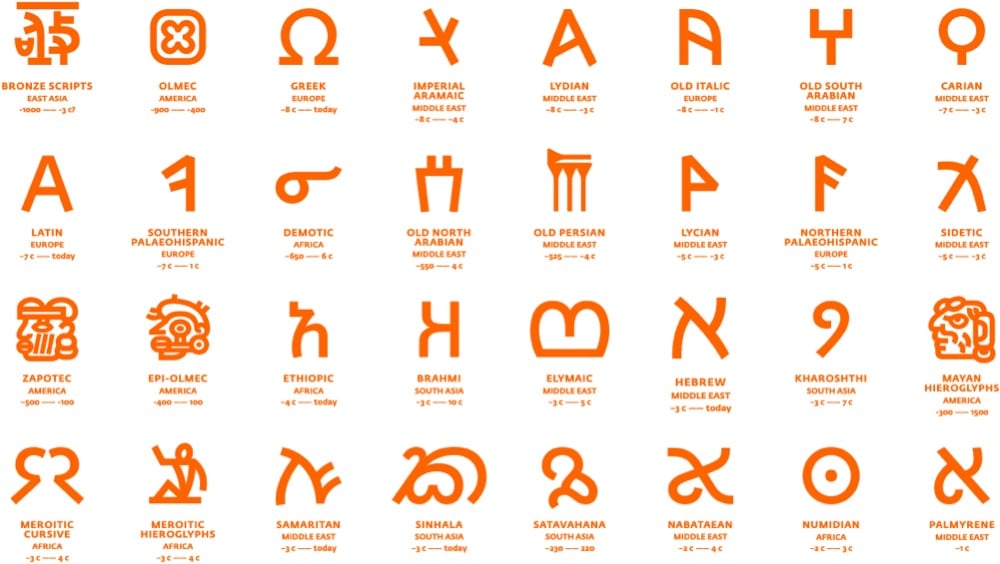

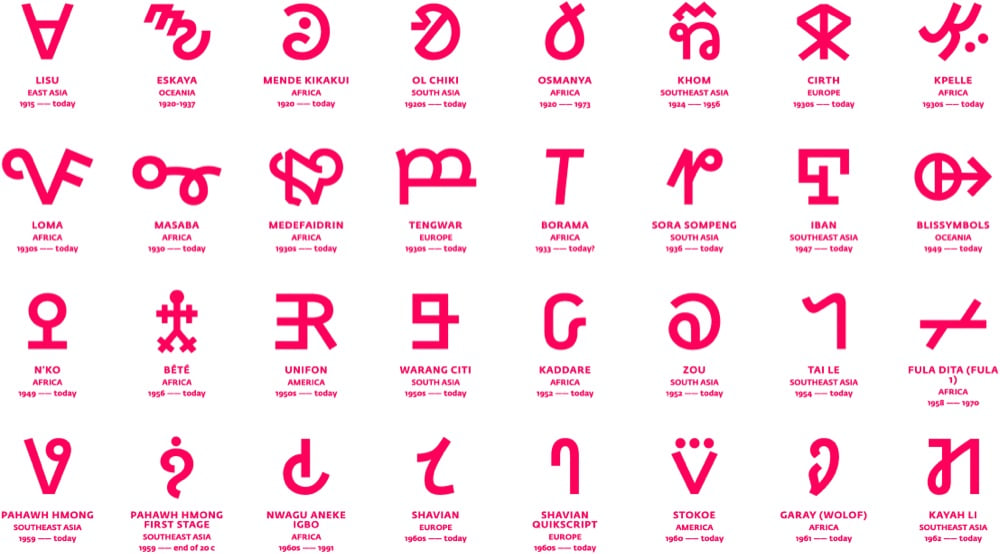
A simple and beautiful listing of the World’s Writing Systems. You can sort by time (proto-cuneiform to Toto), region, name (Adlam to Zou), and whether the scripts are living or historical.
The owner of Tokyo’s Bar Martha: “I have never run a bar that has considered what the customer wants. People often say that the customer is always right, but I’m not confident that’s true.”
They Cracked the Code to a Locked USB Drive Worth $235 Million in Bitcoin. Then It Got Weird. The owner of the USB drive doesn’t actually want them to unlock it.
Barbis! MIT students surprised the school’s president by placing a life-sized Barbie-themed TARDIS in her office. Barbis? Barbis. Barbis!
YouTube recommended this video of people jumping from 100+ foot cliffs in an abandoned quarry in Vermont. I have no desire to ever do this, but it would be fun to go and watch.
The World Solved Acid Rain. We Can Also Solve Climate Change. “Climate agreements and targets take time to evolve. Negotiations are long. The ozone hole and acid rain were not fixed with the first international agreements on the table.”
Lego’s New Dune Set With a Loooooong Baron Harkonnen Minifig


Lego is coming out with a huge new set that’s based on Denis Villeneuve’s two-installment adaptation of Dune (or, as it’s know around these parts, DUNC). OMG, the Baron Harkonnen minifig!! It reminds me of something…ah yes:
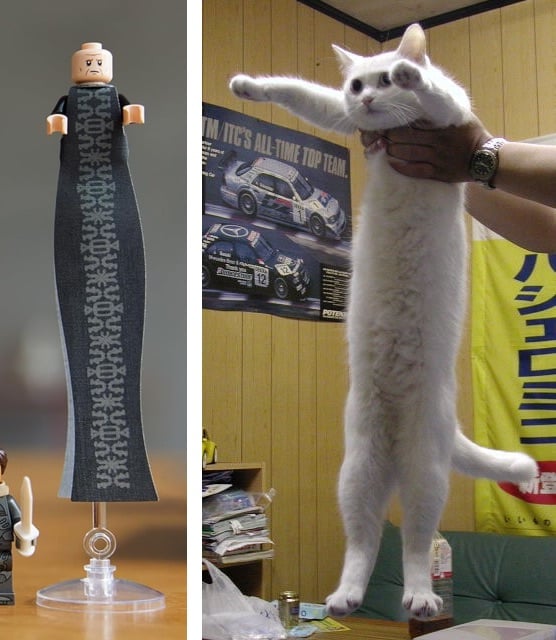
Longbaron is looooooooong.
Anyway, it’s coming out in February and the main build is a 1369-piece model of the Atreides Royal Ornithopter with “fold-out, flappable wings, deployable landing gear and an opening cockpit”. Baron Harkooooooooooooonnen. I can’t stop! I, uh, may have pre-ordered this the second I saw it. (via polygon)
Update: Absolutely perfect:

(via @justgregb)
Hundreds of Gorgeous Vintage Watercolors of Mushrooms

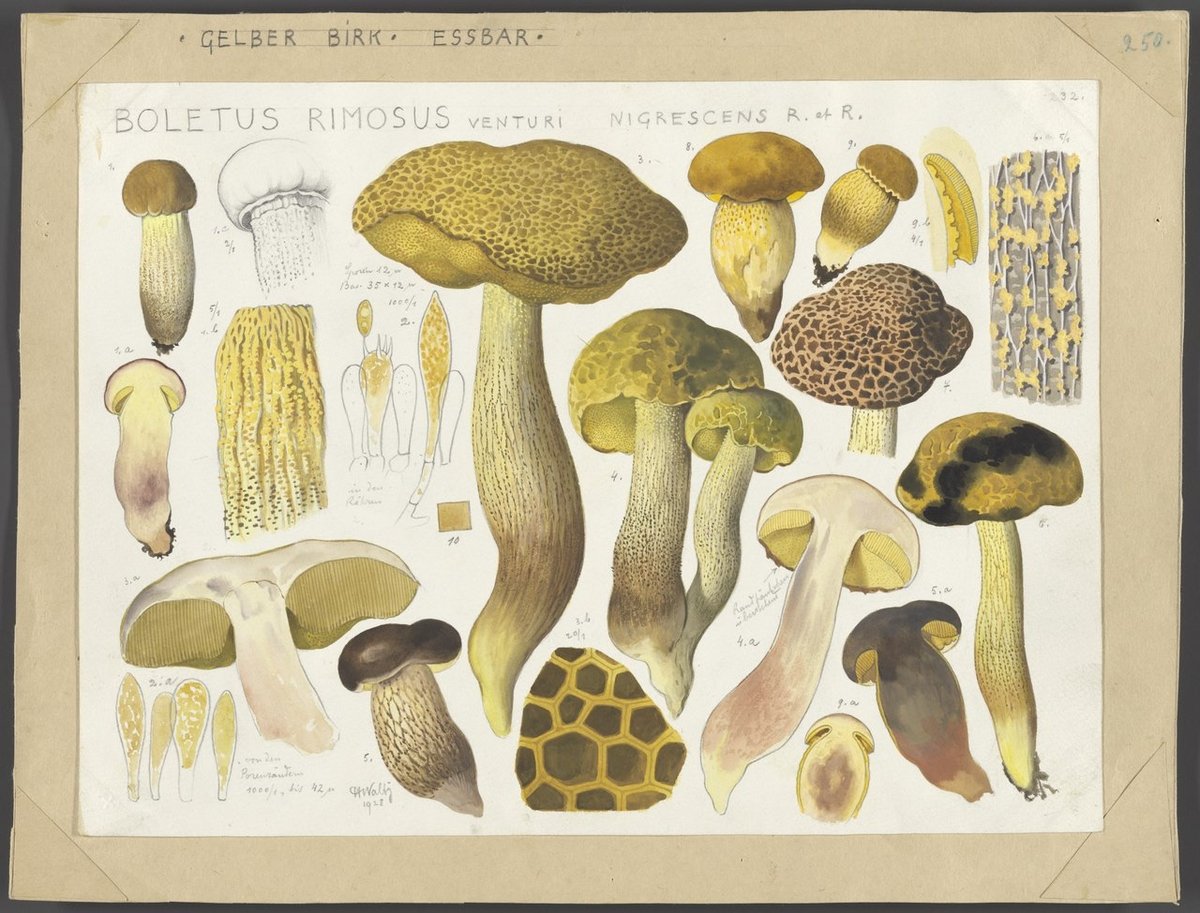
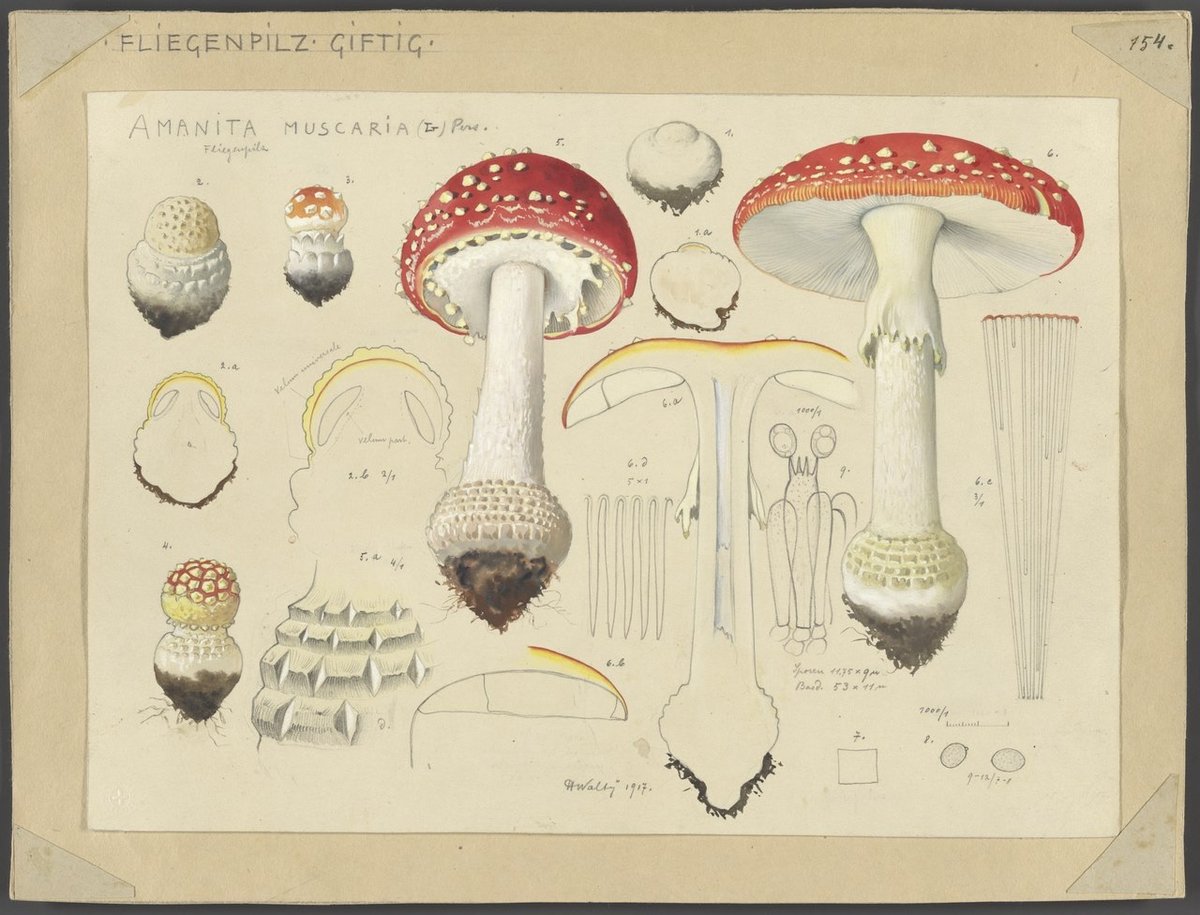

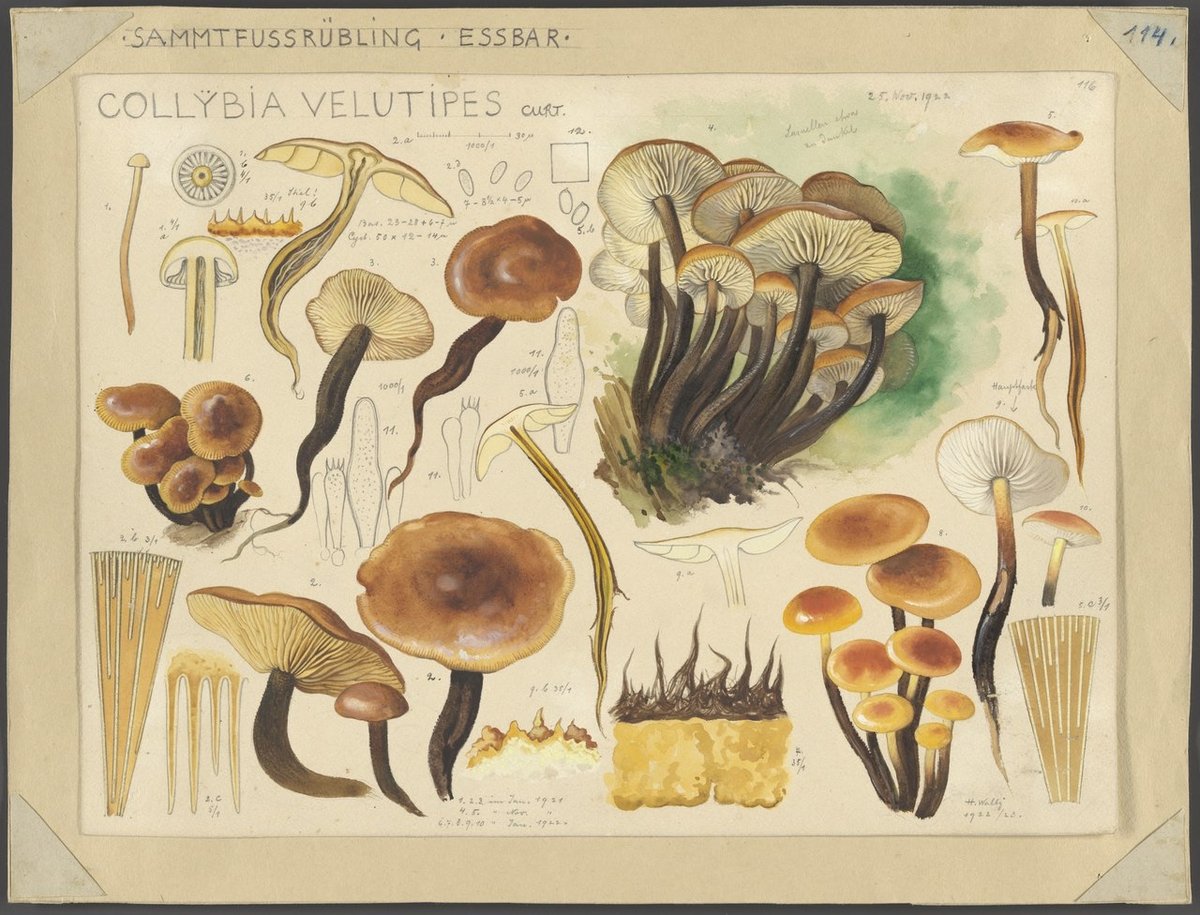
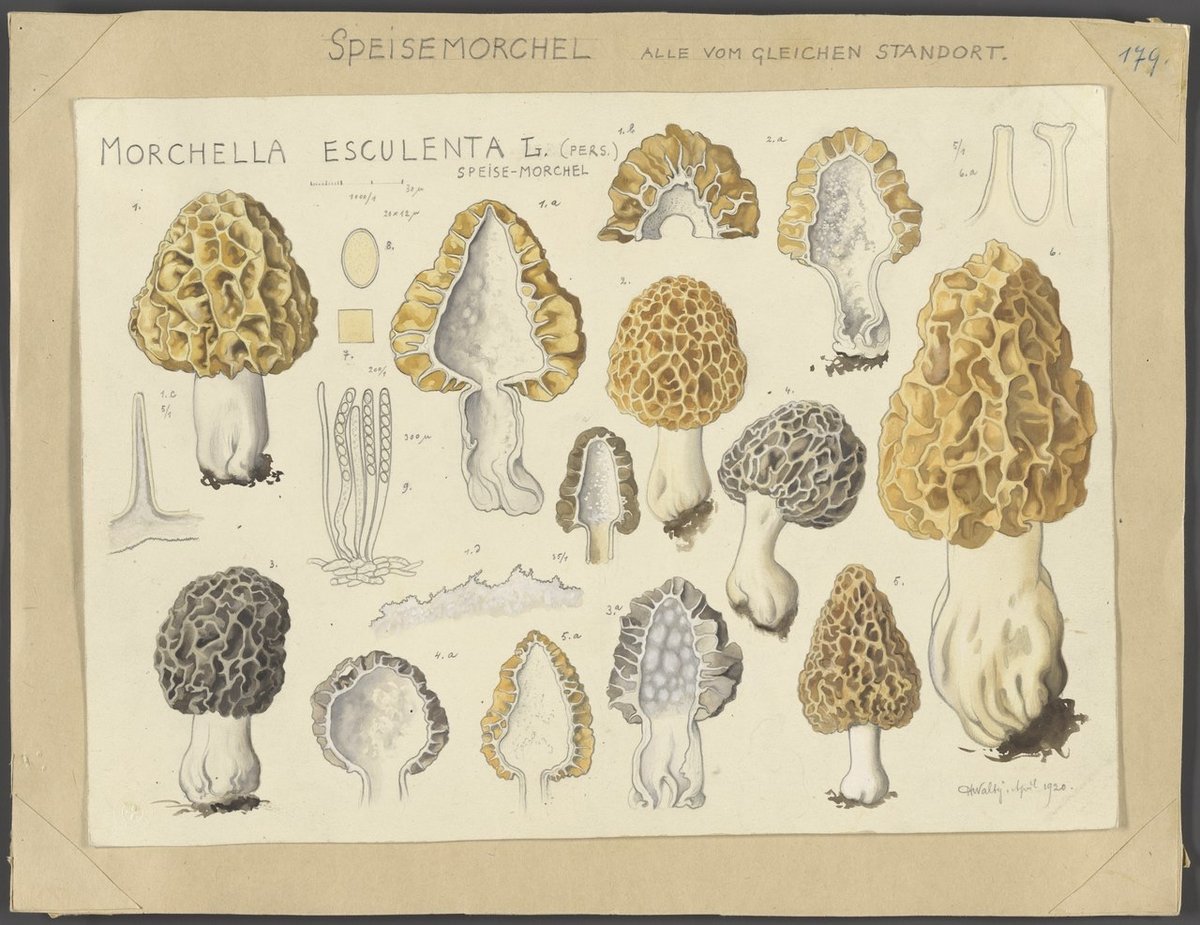

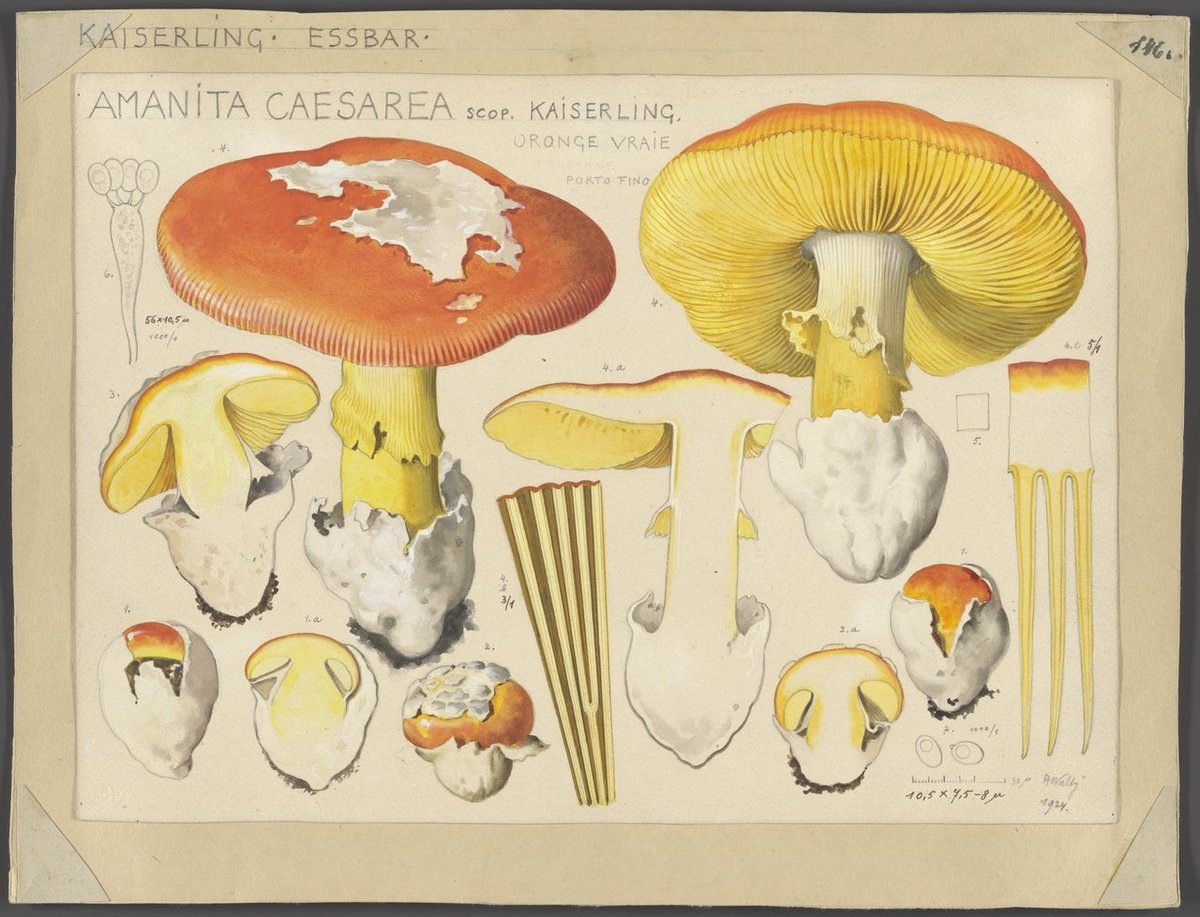
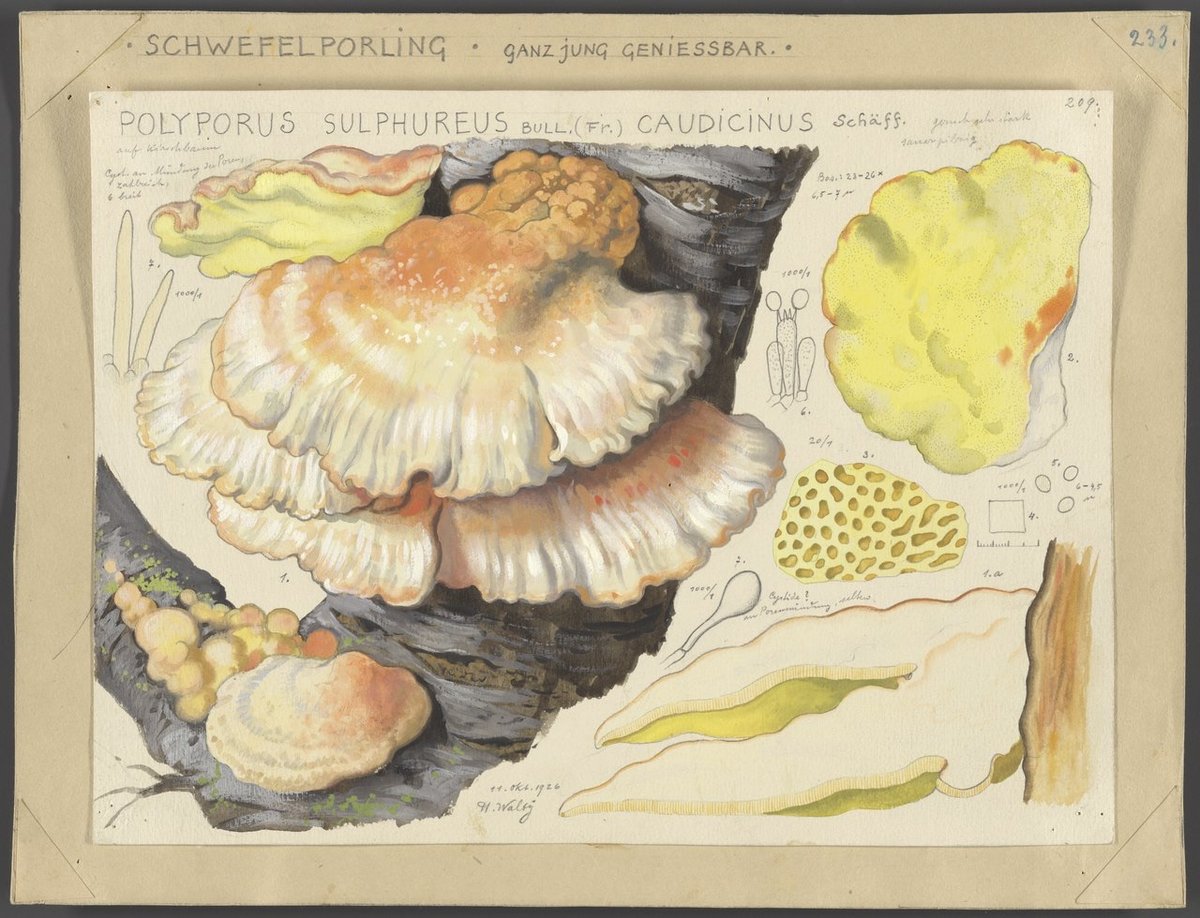
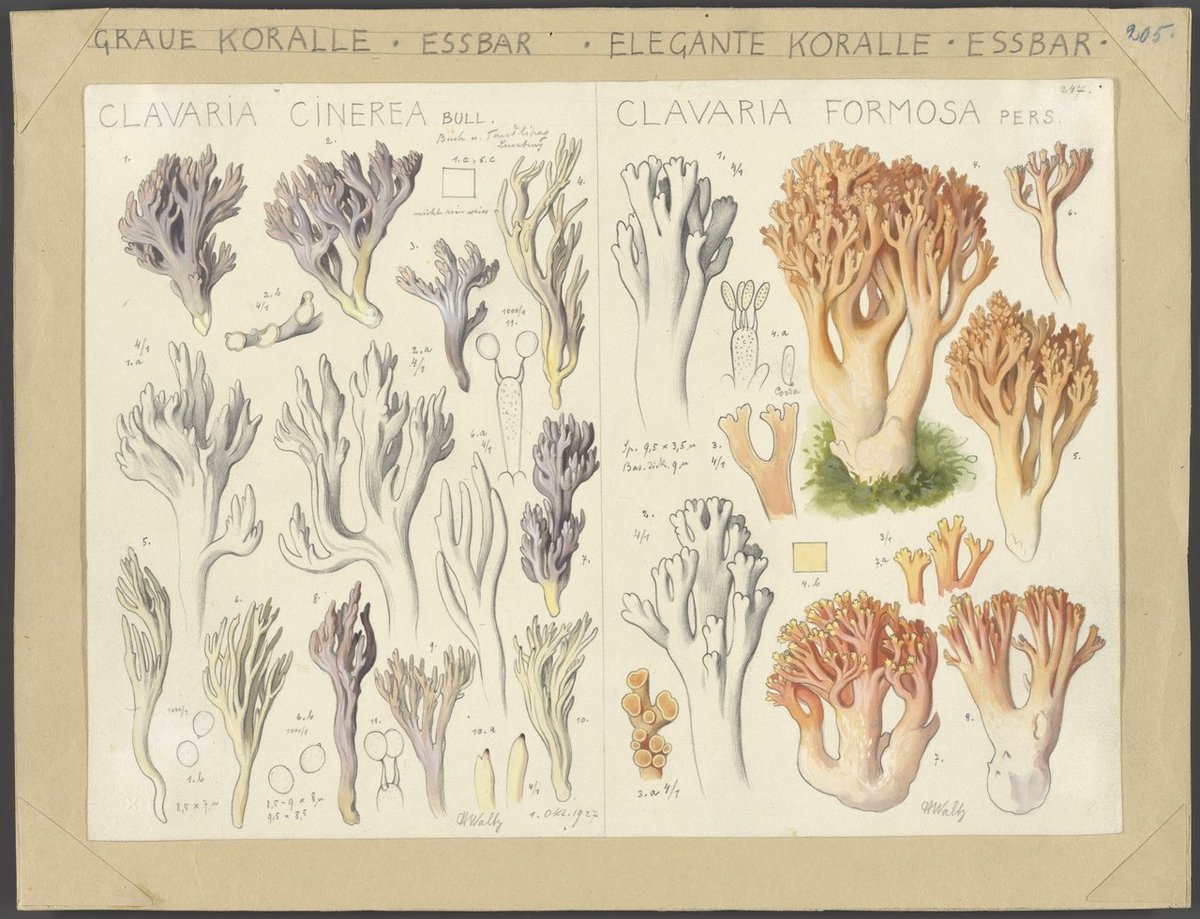

From 1913 to 1944, amateur mycologist Hans Walty created hundreds of fantastic watercolor illustrations of mushrooms, which are available to peruse in very high-resolution at Wikimedia Commons. There’s not a great deal of information about Walty or his drawings online,1 but I did find this piece from the Swiss National Library.
His images depict the colours and shapes of the mushrooms’ fruiting bodies and sometimes also include drawings of microscopic views. The fungi are usually depicted from the side and often from the top and bottom as well. Walty also frequently documented the characteristics of the stems, spores and undersides of the caps. The hobby mycologist also produced an explanatory book to accompany his illustrations that contains descriptions of the mushrooms, with each specimen being assigned a family and genus. His illustrations often contain notes about the time and date the mushroom was found and whether it was edible, inedible or poisonous.
Walty’s illustrations were published in multiple editions of a Swiss mushroom guide from the 40s through the 70s. According to the German version of Wikipedia (translated): “For decades, 500 of his illustrations on mushrooms were considered a standard work on mushroom identification, especially in Switzerland.”
Again, you can browse through hundreds of Walty’s mushroom illustrations at Wikimedia Commons. (thx, christoph)
Not in English at least; Walty was born in Italy and lived in Germany and Switzerland for much of his life. A biography is available on the German version of Wikipedia. ↩
Out next week, a memoir by Olympic champion Caster Semenya: The Race to Be Myself. “This book is a searing testimony for anyone who has been forced to stop doing what they love.”
Papercraft Four-Color Houses

Papercraft artist Charles Young has been sourcing color combinations from this book and using them to construct extremely tidy and precise little buildings.
Starting in May 2020 I used Sanzo Wada’s Dictionary of Colour Combinations as inspiration for a new project introducing colour to my paper work for the first time. The book is made up of two, three and four colour combinations drawn from Japanese design and publishing in the early 20th century.
Check this out to get a sense of the scale — they’re really tiny. You can see many more of these on Instagram. It is actually hard to believe these are made out of paper and not computer generated. (via present & correct)
Craig Mod is walking 143km (89 miles) across the full length of the metropolis of Tokyo over the course of a week and is running a pop-up newsletter that he’ll send out along the way (and then will cease to exist — the newsletter, not Craig or Tokyo).
The 10-Millionth Visitor to the Rijksmuseum Spends the Night Sleeping Under Rembrandt
This story is a few years old but it charmed me too much this morning to let it slide. In 2017, four years after its grand reopening, Amsterdam’s Rijksmuseum welcomed its 10-millionth visitor, a man named Stefan Kasper. His lucky timing resulted in getting to spend the night in the museum, where he dined and slept underneath Rembrandt’s the Night Watch.
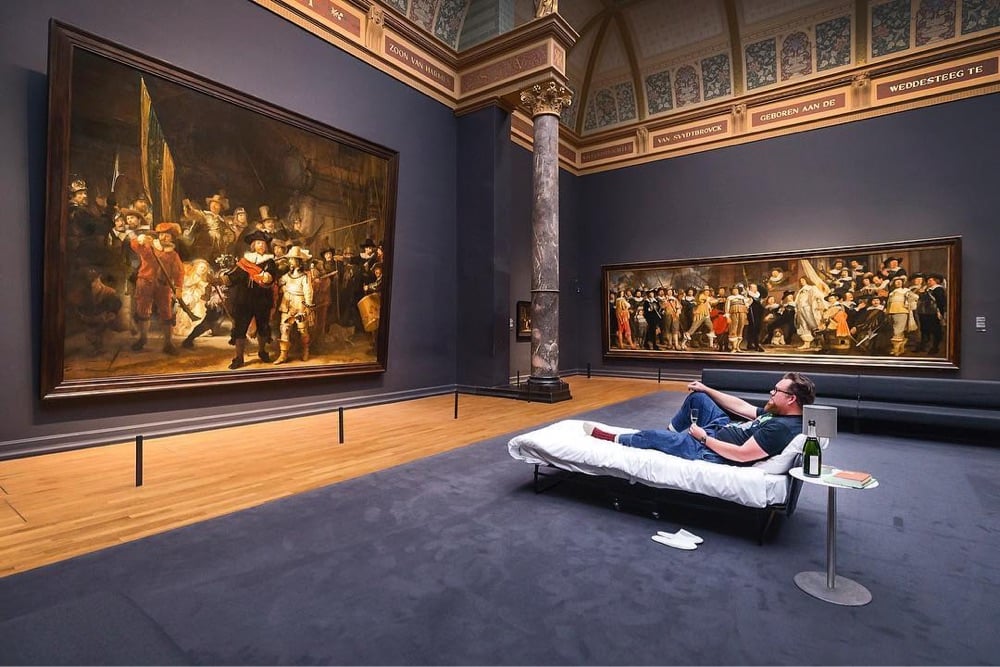
Here’s a short video of Kasper’s time in the museum:
I still can’t believe it. I discovered characters that I have never seen before. They came to life in front of me. It’s an experience that is forever etched in my memory.
Not the same, but I got to go to a press preview when the MoMA reopened a few years ago after renovations and it was quite an experience to wander those familiar galleries pretty much by myself. I stood in front of Starry Night and One: Number 31, 1950 for a really long time that morning.
Been hearing good things about this in my feeds: More Is More: Get Loose in the Kitchen by Molly Baz. The cookbook “encourages more risk-taking, better intuition, fewer exact measurements, and a ‘don’t stop ‘til it tastes delicious’ mentality”.
The Real Reason You Should Get an E-bike: they’re fun! “One of the best ways to improve your life: Ditch your car.”
“The Nature Conservancy estimates that 5.75 billion sunflower sea stars died over the span of three years, a 94 percent global decline.” 94% in 3 years! Climate change + disease is to blame.
How Do Black Holes Compare to Regular Holes?
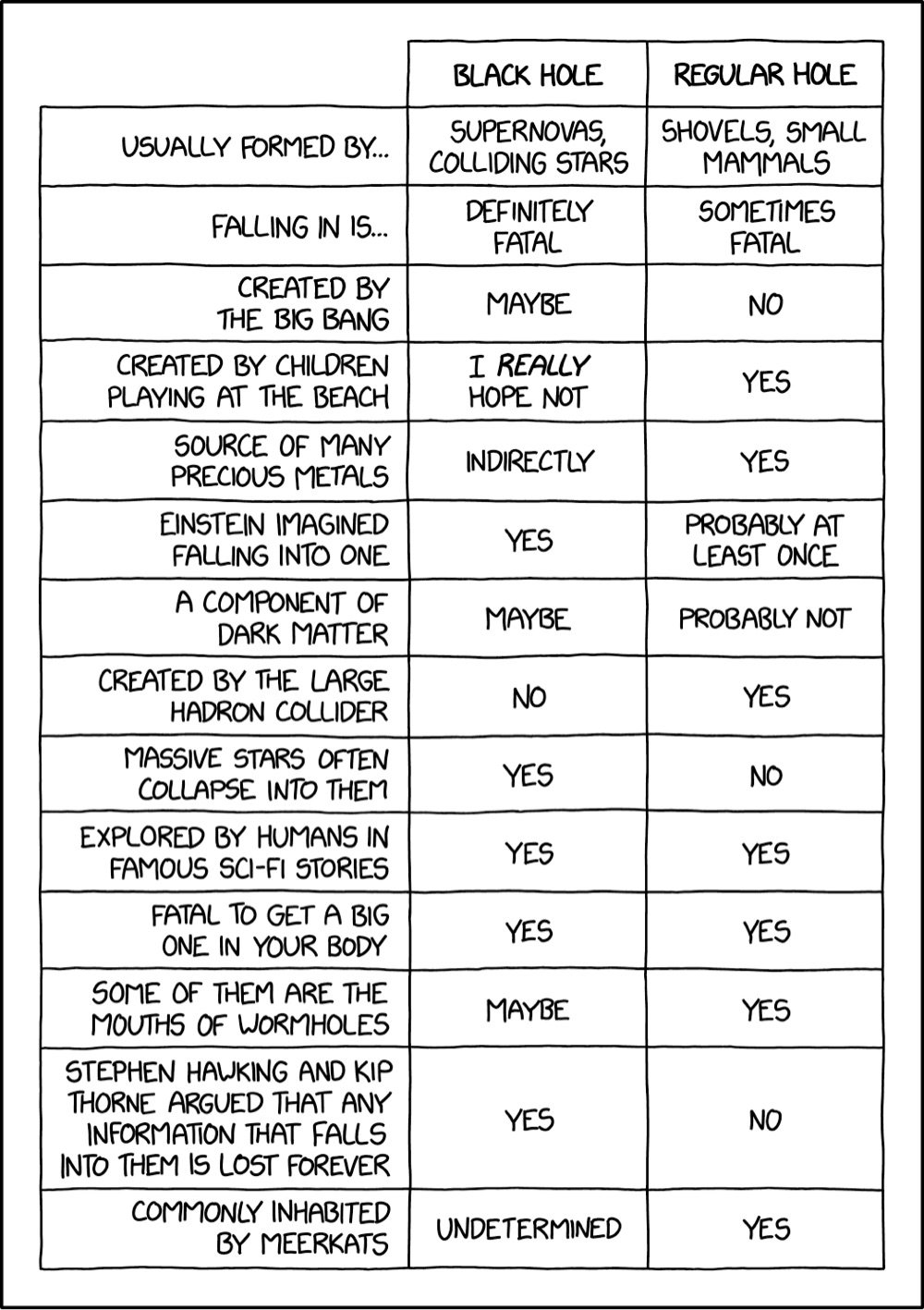
From XKCD, a comparison chart that shows how black holes and regular holes measure up to one another. Some of these are pretty clever: “some of them are the mouths of wormholes”.
The Debt Collective just canceled almost $10 million in student debt for Morehouse College students. They paid $125,000 for the debt.
The English Gave Birds People Names and Some of Them Stuck
In a piece about how English and North American robins (two unrelated species that don’t even share a biological genus or family) got their names, Robert Francis shares how some English birds were given people names…and some of them stuck.
During the 15th century, the English had an endearing practice of granting common human names to the birds that lived among them. Virtually every bird in that era had a name, and most of them, like Will Wagtail and Philip Sparrow have been long forgotten. Polly Parrot has stuck around, and Tom Tit and Jenny Wren, personable companions of the English countryside, are names still sometimes found in children’s rhymes. Other human names, however, have been incorporated so durably into the common names that still grace birds as to almost entirely obscure their origin. The Magpie, a loquacious black and white bird with a penchant for snatching shiny objects, once bore the simple name “pie,” probably coming from its Roman name, “pica.” The English named these birds Margaret, which was then abbreviated to Maggie, and finally left at Mag Pie.[2] The vocal, crow-like bird called Jackdaw was also once just a “daw” named “Jack.”
The English also gave their ubiquitous and beloved orange-bellied, orb-shaped, wren-sized bird a human name. The first recorded Anglo-Saxon name for the Eurasian Robin was ruddoc, meaning “little red one.” By the medieval period, its name evolved to redbreast (the more accurate term orange only entered the English language when the fruit of the same name reached Great Britain in the 16th century). The English chose the satisfyingly alliterative name Robert for the redbreast, which they then changed to the popular Tudor nickname Robin. Soon enough, the name Robin Redbreast became so identified with the bird that Redbreast was dropped because it seemed so redundant.
I found this list of other people names for birds as well — other examples include jays and martins. (via @gretchenmcc)
I’ve been using Mimestream as my MacOS email client for less than a day and it’s already so much better than the increasingly janky Gmail web interface. What’s your email setup these days?
“How Lauren Groff, One of ‘Our Finest Living Writers,’ Does Her Work.”
I am currently reading1 Lauren Groff’s The Vaster Wilds, so I was interested to read about her writing process, which includes:
When Groff starts something new, she writes it out longhand in large spiral notebooks. After she completes a first draft, she puts it in a bankers box — and never reads it again. Then she’ll start the book over, still in longhand, working from memory. The idea is that this way, only the best, most vital bits survive.
“It’s not even the words on the page that accumulate, because I never look at them again, really, but the ideas and the characters start to take on gravity and density,” she said.
“Nothing matters except for these lightning bolts that I’ve discovered,” she continued, “the images that are happening, the sounds that are happening, that feel alive. Those are the only things that really matter from draft to draft.”
And also this:
In the afternoon, Groff deals with the business of being an author, responding to emails, doing publicity, writing blurbs. And she reads. A lot. In just the past few days, she said, she finished “Living and Dying With Marcel Proust,” completed a reread of “Moby Dick,” and started a graphic novel called “Roaming.” She estimates she reads about 300 books a year.
Groff will drop quotes into casual conversation, citing, say, Frank Lloyd Wright’s take on form and function, but she manages to do this in an entirely unaffected way, just tossing out an interesting nugget for consideration. Her editor, McGrath, said that Groff reread all of Shakespeare so she could write a version of “The Vaster Wilds” in iambic pentameter “just for fun,” as a way for her to master Elizabethan rhythms.
All of Shakespeare, just for fun. Yep.
Or at least, trying to read. I’ve been super busy with work and at the end of the day, the last thing I want to do is read more. But I will get back to it!↩
I may have hallucinated this but I think a bunch of folks were talking about this book on Bluesky yesterday? Three Bags Full: A Sheep Detective Story. “It’s rather as if Agatha Christie had rewritten The Wind in the Willows…”
Happy 17th anniversary to The Marginalian, Maria Popova’s bloggy love-letter to the diversity and profundity of the human experience.
“An off-duty pilot who was in a jump seat in the cockpit of an Alaska Airlines flight on Sunday has been charged with more than 80 counts of attempted murder.” 80 counts of attempted murder!
Ella Fitzgerald & Mel Tormé Answer “What Is Jazz?”
This is wonderful: at the 1976 Grammys, Mel Tormé asked Ella Fitzgerald how she explains to people what jazz is and then the pair of them effortlessly launch into a scat duet that is just fantastic to listen to. Ella Fitzgerald, what a voice! Mel Tormé, what a voice! Here’s the pair performing together in the 60s:
Super Mario of the Flower Moon is my personal Barbenheimer. “Two great artworks from important small Italians on the same day?!”
An analysis by Mona Chalabi: “The New York Times has consistently mentioned Israeli deaths more often than Palestinian deaths.” And Israelis are mentioned by name and Palestinians are often anonymous. I have noticed this as well.
Running in a Body That’s My Own: runner Caster Semenya’s long struggle to compete as herself. “Its restrictions aren’t about leveling the playing field; they are about getting certain types of women off the field completely.”
The Bird Migration Explorer

I loved playing around with the National Audubon Society’s Bird Migration Explorer, which is a beautifully designed interactive map of the Western hemisphere that shows the seasonal migration patterns of more than 450 species of birds. What a resource…so much information to explore here. (via marco c. in the comments)
Evangelical Christians yearning for the Second Coming want Israel to wipe out the Palestinians, followed by the “annihilation of the Jews”. “What it amounts to is cheering on Armageddon from the cheap seats — and directing funds to ensure it occurs.”
Who Are the People in the Neighborhood?
One of the things I was thinking about doing with the comments is having posts on Fridays that are specifically participatory. So let’s try it out today. Currently, there’s no profile information available for commenters…you can’t click on a name to visit their Instagram acct or whatever. That feature is on my to-do list but it might be awhile before I get to it. But I know folks are curious about who reads the site…
So, in the meantime, if you feel comfortable sharing, you can use this thread to introduce yourself: maybe where you live, what you’re into, your social accounts. I think many of us smartly err on the side of not sharing too many specific details about ourselves online (myself included, but it’s obviously complicated 🙃) due to safety issues, but I think it’s possible to get to know each other a little bit without spilling too many beans. (thx to Russell for the idea)
How’s Everyone Liking the Comments?
Hey everyone. I rolled out a new comments system (in beta!) on Monday and it seems to have been well-received so far. I’ve fixed some of the most egregious bugs and rolled out some tweaks and it seems to be holding up pretty well. 🤞 (Is there a knock-on-wood emoji?)
It’s early days and I’m rolling things out slowly (only ~10 posts were open for comments this week out of about 50), but commenting activity waned as the week went on. Discovery is still poor (there’s no list of open comment threads) and there aren’t any notifications — even as an admin user, I have to go to the front page of the site and click into individual threads to see if there’s anything new. That’s an obvious hinderance to participation and I’m gonna make a first pass at fixing it next week.
I also recognize that it’s tough for readers to make room for a new online social space. People have their routines with Mastodon, Threads, Reddit, Instagram, etc. and each of those spaces has different social norms and unspoken rules. Getting used to a new space and learning what it’s “for” takes time. At the end of the day, it’s on me to facilitate discussion here. I’m not used to writing posts to spark conversation and it’s gonna take some time for that muscle to develop and to find a balance — I don’t want the site to become a series of prompts. (“Here’s a cool thing about giraffes. Do YOU like giraffes?” 🥴)
Like LLMs, we’ve all been trained on contemporary social media and tend to interact online in that way now. But per the community guidelines, I’m asking us to try for a slightly different sort of discussion:
There are three types of feedback I get often via email or social media that I love: 1) when someone sends me a link related to something I’ve shared (often with a short explanation/summary), 2) when a reader with expertise about something I’ve posted about shares their knowledge/perspective, or 3) when someone tells a personal story or shares an experience they had related to a post or link. When readers share this sort of constructive feedback, it improves the original post so much…that’s what I want to happen with comments on kottke.org.
The internet is full of places for people to go to express their opinions or argue about others’ opinions, so I’d like to steer away from that here. If we can prioritize talking about facts, sharing stories, experiences, and expertise over opinions, it’ll make for better, more informative threads.
I’d also like folks participating in threads to think a little bit less about what you might want out of making a comment and a little bit more about how your comment might help improve the community’s understanding of the topic at hand.
When I think about the posts & comments on social sites that I’m most interested in, they’re often experiences/personal stories, informed opinion, or, my personal favorite, links to related content. I’m gonna share some comments from this past week that hit these marks. First is Steven’s comment in the best 50 bars thread:
Our friend Kate Mikkelson has been tracking the best bars for years and maintaining her own list which may be of some relevance here. We were just in Brooklyn and while we didn’t make it to any of the bars on the most recent list we did go to Long Island Bar (twice) and had the best martini we’ve ever had, and enjoyed a great meal with excellent cocktails at Maison Premiere. Probably the best bar we’ve been to in recent memory was Artillery, in Savannah, but we’ve been lucky to visit many others, both with Chris and Kate and without, mostly in New Orleans, San Francisco, and Austin.
An excellent link, some context, and a little personal story.
I loved everyone sharing their favorite music videos in this thread. It took some cajoling by Caroline, but the thread got instantly better for everyone when people started sharing links to the videos they were talking about. Sharing links is a form of Showing Your Work and it only takes a few additional moments.
Though it contains fewer than 10 comments, I thought the best thread of the week was on the What a Japanese Neighborhood Izakaya Is Like post. I easily could have pinned every comment in the thread but I’ll highlight two here. First, this one by Thom:
One of the best gift’s a friend ever gave me was (silently) insisting we always meet at the same coffee shop. Over time, the connections we created and overall vibe of doing so spilled into other aspects of my life, especially when I travel. Usually when you go somewhere new you want to try as many things as possible. But I try and go to the same place repeatedly, glorying in the warmth of them learning my name, picking up on what I like to order, and finally telling me about things I should check out they think I’d like.
I don’t know if it’s a skill to do so, but, having now moved between cities and countries multiple times in my life, it’s my first objective when I find a new home. Go somewhere enough times until they know my name. In this small way it feels like my spending money there matters more than it would in a place where the staff turnover even day by day would make this impossible.
And Josh:
Love this. I recently stumbled onto a show on Netflix called Midnight Dinner about a guy who runs a Izakaya (though I didn’t know what it was called until this post). It follows the stories of his regulars and has been warm comfort TV as the nights get colder. Y’all might appreciate it as I’ve been doing.
I’ve added Midnight Dinner to my Netflix queue — I hadn’t heard of it before. Comments like these make whatever posts I’ve written so much better — many thanks to these readers and everyone that else that took the time to comment this week.
I’ve been working nights and weekend for the past few weeks to get this thing going, quite happily for the most part, but I’m wiped. So I’m taking the rest of the day off (aside from one more post (with comments on!) after this one) to get a few things done around the house, do a bit of reading, and go watch my daughter play soccer. I’ll see you next week!
Estonia’s capital made mass transit free a decade ago. Transit traffic went up but car traffic increased faster. “Any extra money should be put toward transit service, and not zero fares.”
Tape Measure Spider-Man. So dumb and yet perfect.
Scientists lay out a sweeping roadmap for transitioning the US off fossil fuels. “A 600-plus-page report from the National Academies of Science includes 80 recommendations for how the U.S. can achieve its target of net-zero emissions by 2050.”
Ed Zitron completely dismantles Marc Andreessen’s “outdated and childish” techno-optimist manifesto. “These people do not care about the future. They are eternally mired in the past, grinding their axes and scowling at those who would stop them…”
All of the Whole Earth Catalog Is Now Available Online for Free


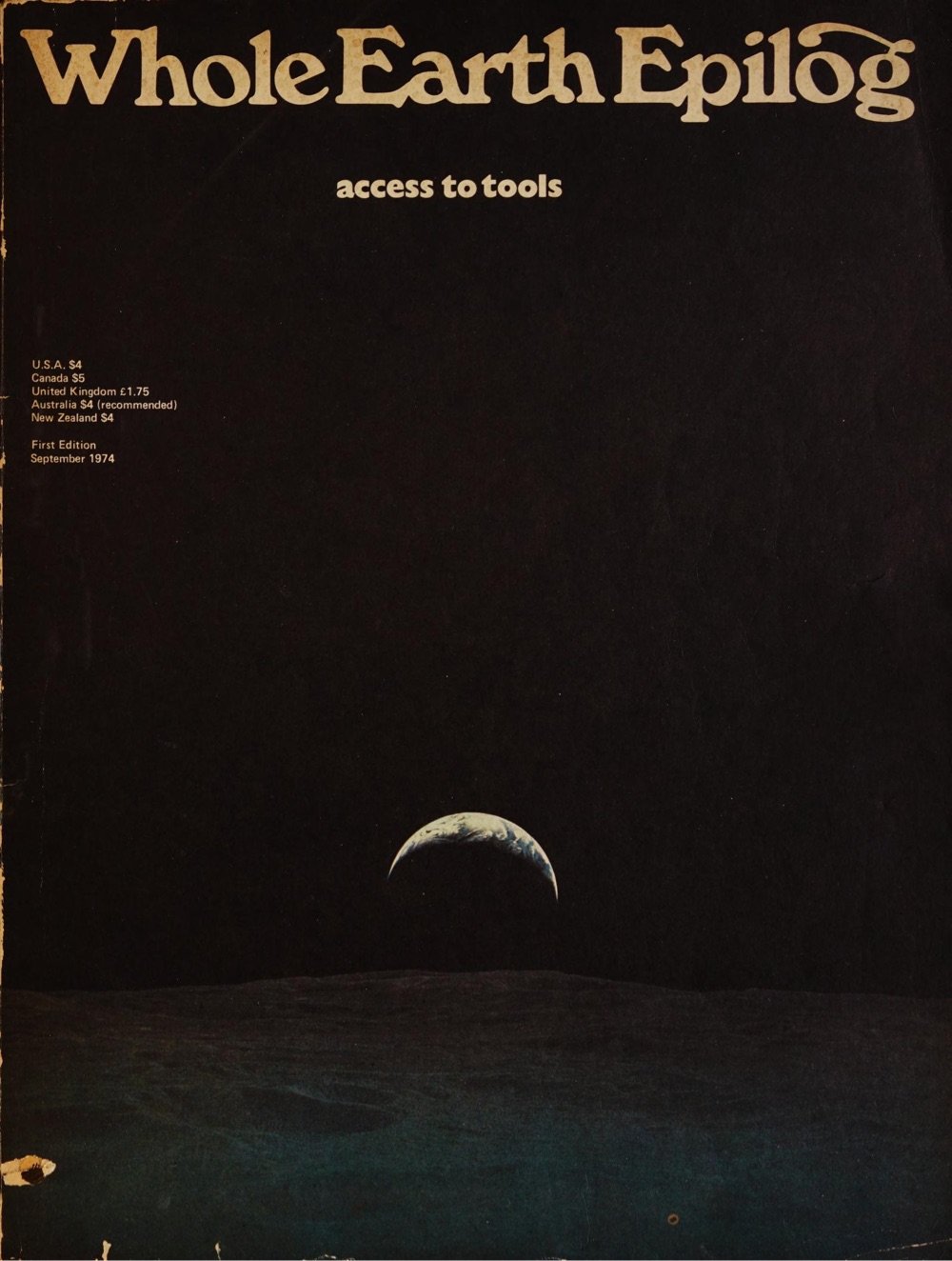
The influential Whole Earth Catalog, along with a number of related publications, has been uploaded to The Internet Archive and is now available online for free at the Whole Earth Index. From Wired:
The Whole Earth Catalog was the proto-blog — a collection of reviews, how-to guides, and primers on anarchic libertarianism printed onto densely packed pages. It carried the tagline “Access to Tools” and offered know-how, product reviews, cultural analysis, and gobs of snark, long before you could get all that on the internet.
At the time of its initial publication in the late 1960s, the periodical became a beacon for techno-optimists and back-to-the-land hippies. The Whole Earth Catalog preached self-reliance, teaching young baby boomers how to build their own cabins, garden sheds, and geodesic domes after they had turned on, tuned in, and dropped out — well before they grew wealthy enough to buy up all the three-bedroom single-family homes. The catalog also had a profound impact on Silicon Valley’s ethos, and is credited with seeding the ideas that helped fuel today’s startup culture.
Martin Scorsese’s 81 Greatest Movie Characters, Ranked. So many great characters here that even Bill the Butcher barely cracks the top 10.
The Economist: “Although the official number of deaths caused by Covid-19 is now 7M, our single best estimate is that the actual toll is 27.1M people. We find that there is a 95% chance that the true value lies between 17.9M and 32.9M additional deaths.”
Sandra Newman’s Julia is a bold retelling of Orwell’s 1984 from the perspective of Winston Smith’s lover. From a review: “About halfway through, I began to feel more convinced by Julia’s responses to this totalitarian state than I had ever been by Smith’s”.
David Byrne’s Dance Rehearsals for Stop Making Sense
Even if you haven’t seen Stop Making Sense, you are likely familiar with the herky jerky dance moves of Talking Heads’ frontman David Byrne. In this video, which has only recently been made public, you can see Byrne practicing his now-iconic moves.
40 years ago, David Byrne rehearsed dances for Talking Heads’ upcoming Speaking in Tongues tour by recording video of himself to determine which moves worked better than others, which developed into many of the iconic moves seen in the Stop Making Sense movie, filmed at the end of 1983 and released in 1984. It was recently rereleased by A24 in restored 4K. These videos, recorded in David Byrne’s loft, have been mentioned before in interviews and now after 40 years the footage is finally available!
If you don’t want to sit through the full 25-minute video, here’s an hors d’oeuvres version:
(via open culture)
Great story about going to see Galaxy Quest in an empty theater near the end of its run. “The projectionist strode down the aisle toward me [and] my first thought was that the matinee was canceled due to low turnout…”
An index of dozens of aesthetic categories, from Boho Chic and Corporate Gen-X Cyber to Whimsigothic and Internet Awesomesauce.
Is Rural America Even a Thing?
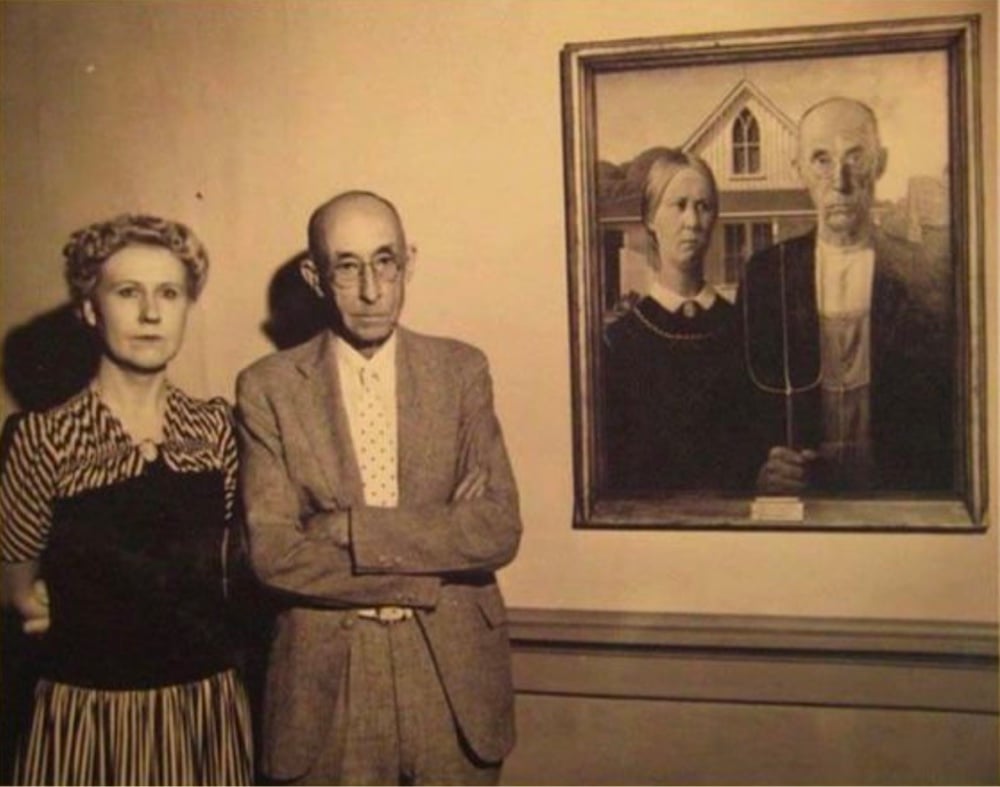
For the New Yorker, Daniel Immerwahr reviews a new book, Steven Conn’s The Lies of the Land: Seeing Rural America for What It Is — and Isn’t (Bookshop.org), which makes the case that what we typically think of as rural America or “real America” is a mirage.
A piercing, unsentimental new book, “The Lies of the Land” (Chicago), by the historian Steven Conn, takes the long view. Wistful talk of “real America” aside, Conn, who teaches at Miami University, in Oxford, Ohio, argues that the rural United States is, in fact, highly artificial. Its inhabitants are as much creatures of state power and industrial capitalism as their city-dwelling counterparts. But we rarely acknowledge this, Conn writes, because many of us — urban and rural, on the left and the right — “don’t quite want it to be true.”
For one thing, the predominant rural population in what is now the United States was coercively removed and eliminated by the federal government:
Settlers styled themselves as pioneers who had won their land with their bare hands. This is how it went in “Little House on the Prairie,” with the frontier family racing ahead of the law to seize Indian property. (“Little Squatter on the Osage Diminished Reserve” would have been a more accurate title, the literary scholar Frances W. Kaye has archly suggested.) Yet in the end land ownership came, directly or indirectly, from the state. The Homestead Act of 1862, along with its successors, gridded up and gave away an area the size of Pakistan. And although homesteading sounds like a relic from the sepia-toned past, its most active period came, the historian Sara Gregg has pointed out, in the twentieth century. The final homesteader got his land in 1988.
1988! The very next paragraph:
One irony is that — after Indigenous towns — it’s the havens of the East Coast ‘elite, such as Boston, New York, and Philadelphia, which have the deepest roots. Most bastions of “real America” are, by contrast, relatively new. Wasilla, Alaska, where Sarah Palin served as mayor, really is a small town in a farming area. But most of its farms were created by a New Deal campaign to relocate struggling farmers from the Upper Midwest. (Hence Palin’s “you betcha” accent, similar to the Minnesota ones in the film “Fargo.”) Palin’s proud patch of “real America,” in other words, was courtesy of Franklin Delano Roosevelt.
This is one of those pieces I could quote every other paragraph so I’m gonna stop there.
Poet Lemn Sissay: “Superman was a foster child. Harry Potter was a foster child. Jane Eyre was adopted. Luke Skywalker was fostered. The fostered, adopted, and orphaned child is central to popular culture.”
How Large Before It Goes In?
One of the best uses of technology is to make people laugh. In this three-part series, the Numerical YouTube channels uses some simple editing to increase the size of the goal until some laughably off-the-mark strikes by professional footballers Ousmane Dembélé, Harry Kane (his penalty miss vs France), and Nicolas Jackson finally find their targets. The misses just get more and more funny as the goal gets bigger.
While Ikea was refurbishing a building for a new store in London, they covered it with scaffolding that looks like a giant, blue Ikea bag. “It’s a simple idea, maybe the most obvious idea, and all the better for that. Nothing else needed.”
Great Books Explained
One of my recent favorite YouTube channels is James Payne’s Great Art Explained, which does exactly what it says on the tin, showcasing works of art like Starry Night, the Great Wave, and A Sunday on La Grande Jatte. Payne recently launched a new channel in the same vein: Great Books Explained. Here’s a trailer, featuring a short clip of his exploration of Alice’s Adventures in Wonderland.
Being an avid reader, I always wanted to do a book channel as well, but did not have the time, so these films are collaborations with different writers who are passionate about certain books, and the first release will be James Joyce’s Ulysses (in this case co-created with Henry Mountford). This will be followed by Alice.
The video on James Joyce’s Ulysses is out now:
(via open culture)
Nomophobia is the fear of being without your mobile phone. “The term is short for ‘no mobile phone phobia’.”
She Was Oprah Before Oprah. A profile of Alice Travis, the first Black woman to host a nationally syndicated talk show. “Travis’s goal was to treat her audience with respect and to present a nuanced portrait of modern Black womanhood…”
The Winners of the 2023 Nikon Small World Photomicrography Competition
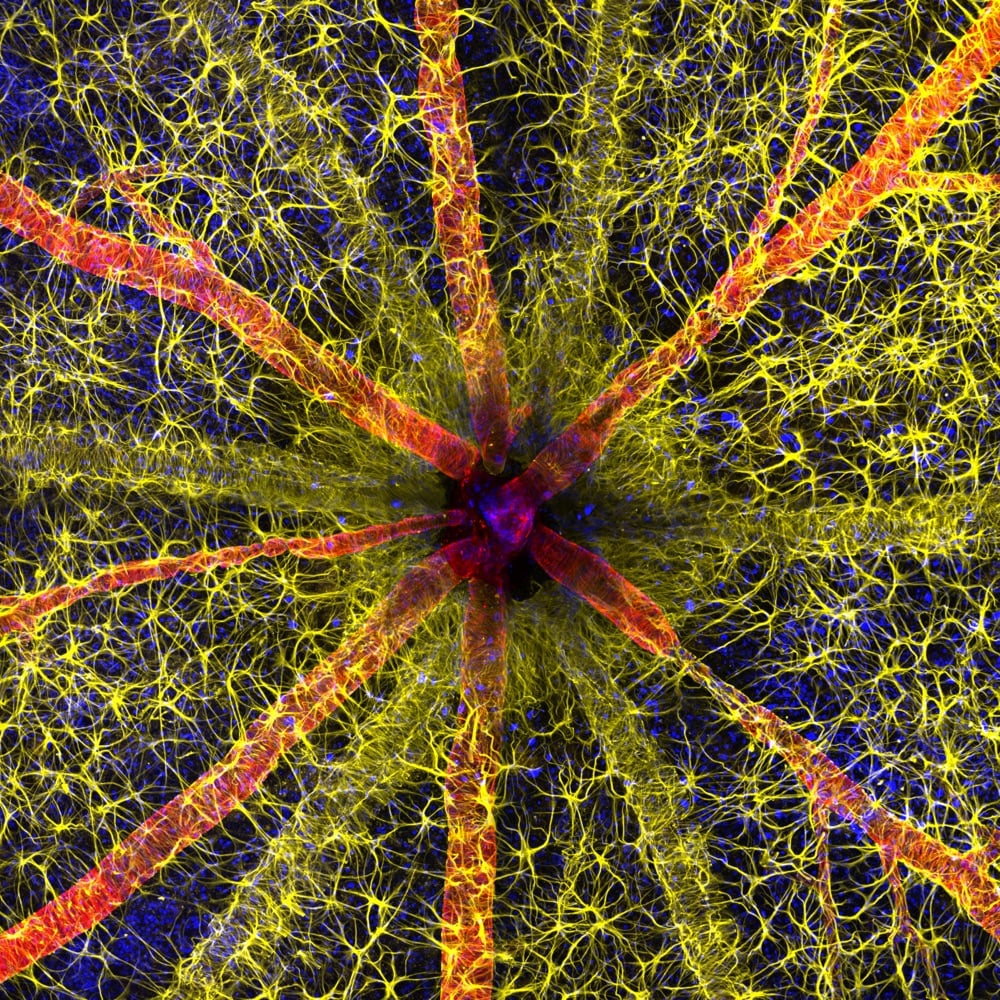


Nikon has announced the winners of the Small World Photomicrography Competition for 2023. I’ve included a few of my favorites above. From the top:
- The optic nerves of a rodent by Hassanain Qambari & Jayden Dickson.
- A heart shape is visible amongst breast cancer cells shot by Malgorzata Lisowska.
- Sunflower pollen on an acupuncture needle by John-Oliver Dum.
And I love a good slime mold photo too. (via ars technica)
Analogue is making a console that will play Nintendo N64 games with 100% compatibility (no emulation). 4K, Bluetooth for controllers, more features to come. You’ll never get one though — all their stuff sells out in like 4 seconds.
Sure, Trump Is an Authoritarian Grifter, but at Least He’s Three Years Younger Than Biden. NY Times op-ed page 🤝 independent moderate voters.
Project Primrose: Interactive Digital Fashion
At their recent creativity conference, Adobe showed off Project Primrose, in the form of a dress that changes colors and patterns at the click of a button. The garment could also display animations, including ones that respond to the wearer’s movements. From The Kid Should See This:
Created with small scales or petals that are programmed with Adobe software, the futuristic ‘fabric’ can be used for clothing, handbags, curtains, furniture, and endless other surfaces.
Research Scientist Christine Dierk and her team designed and programmed everything about it. Dierk also stitched it together.
Mario Can’t Be Super Without Psychedelic Power-Ups. “Nintendo’s mascot is boring. So for nearly four decades, it has fed the jumping plumber an increasingly bizarre diet of items.” 🍄😂
Extremely relevant to my interests: the New England Cider Donut Map. Over 350 donut destinations, including my favorite: Burtt’s Apple Orchard.
Just announced: The World’s 50 Best Bars. I’ve been to a few of these and would like to go to the rest sometime please.
Pepper X, developed by the founder of PuckerButt Pepper Company, is now the spiciest pepper in the world, measuring 2.693 million on the Scoville scale. The old record was 1.64 mil. “That scale’s logarithmic, so it’s more like three times hotter.”
How Far Does $1 From 1999 Go Today? A visualization that uses the Consumer Price Index to measure how much prices have increased for things like food, housing, medical expenses, and education. Would love to know why medical exp. is a straight line!
To promote his forthcoming book on keyboards called Shift Happens, Marcin Wichary made a little quiz game based on the book’s slipcase cover (which consists of 45 shift keys from 100+ years of keyboards).
The Eye of the Universe Looking Back at Us
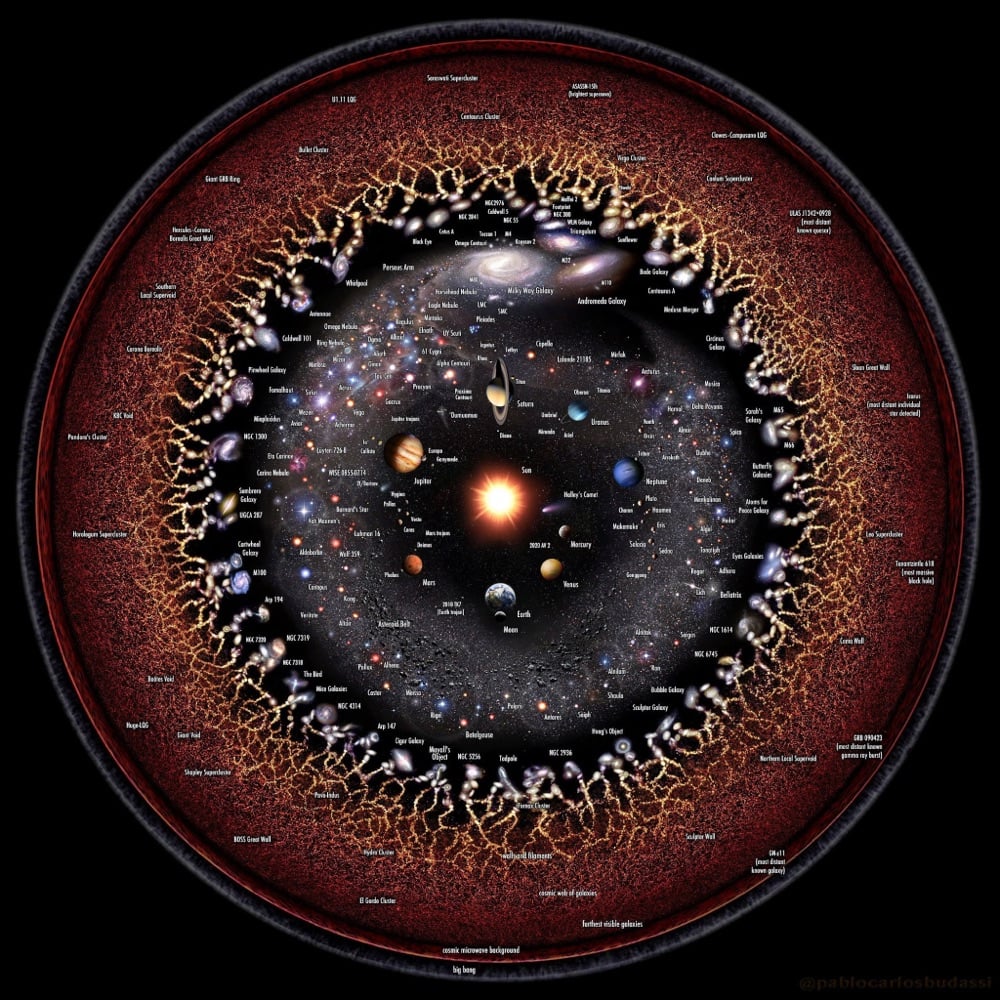
From illustrator Pablo Carlos Budassi, this is a circular map of the universe.
The solar system is located in the center. Towards the edges, the scale is progressively reduced to show in detail the most distant and biggest structures of the observable universe sphere.
There are several other representations of the universe on Budassi’s site, including links to prints, posters, and other products.
It was cloudy and I worked all weekend (on comments), so I didn’t get to see much about the annular solar eclipse. I dug up some eclipse photos online but am curious if you’ve seen (or taken!) any worth sharing?
A quick update about the Design Squiggle t-shirt: the other day I sent another donation to the National Network of Abortion Funds for $2,352.00. Thanks so much for helping support an organization working to provide vital health care to those who need it.
One Hundred & Forty Characters
This is a heck of a time capsule: back in 2011, Chris Floyd photographed 140 people that he followed on Twitter over the course of a year and made a video featuring their portraits and audio of them “talking about Twitter and it’s effect on the way we communicate and form relationships in the modern era”. It’s almost quaint hearing people talk about the site in the time before Gamergate, 4chan, and other factors helped twist it into a very different place.

You can check out more of Floyd’s photographs and people’s stories on the One Hundred & Forty Characters blog. (via noah kalina)
Out today: Deb Chachra’s new book, How Infrastructure Works: Inside the Systems That Shape Our World. This has been getting great reviews in my feeds from folks who got an early look at it.
What To Know About What’s Happening In Israel And Gaza. “Q: Where can I learn more? A: This is a logistically and morally complex situation involving decades of recent history and thousands of years of context, so try your cousin’s Instagram stories.”
A Vermont utility company wants to install batteries in most customers’ homes and bury more power lines. As a VT resident and GMP customer (and EV owner) whose power goes out probably once a month because of downed trees, I like this a lot.
The 50 Greatest Music Videos of All Time, Ranked
A.V. Club has taken on the task of ranking the best 50 music videos, from the first video ever played on MTV (Video Killed the Radio Star by The Buggles, featuring none other than soundtrack composer Hans Zimmer on keys) to Thriller, Sabotage, Addicted to Love, and Sledgehammer. You can watch the whole list via this playlist on YouTube.
I loved the video for Sledgehammer. I was 12 years old the summer it came out. We didn’t have cable TV then, but I’d turn on MTV anywhere I could, hoping for a glimpse of it. My dad used to take my sister and me on roadtrips all over the country and I vividly remember the rare times we got to stay in a motel (they had to have a swimming pool with a diving board), turning on MTV, and catching that Sledgehammer video a few times every hour. It was only years later, after becoming a Wallace and Gromit fan, that I learned that — of course! — Aardman had done the animation for Sledgehammer.
Thanksgiving FYI is a seasonal newsletter from Jim Ray (“an enthusiastic and dedicated home cook with more than a dozen Thanksgivings under [his] belt”) that’ll bring you tips and recipes to help with your T-Day festivities.
What a Japanese Neighborhood Izakaya Is Like
This is great and I loved it to bits: a 15-minute video from the Life Where I’m From YouTube channel about a tiny izakaya (13 seats!) in Tokyo owned and operated by a woman called “Mama” by her regulars.
When Mama is busy, regulars at this izakaya will serve themselves, get their own beers, get their “bottle-keep” and make their own drinks. They’ll also help out Mama-san by serving other customers as well. […] Bottle keep is when a customer buys a bottle and the shop holds on to it for them. Then the next time they visit they can drink from that bottle again.
I’ve got lots of thoughts about this and connections to make! The izakaya’s casual help-yourself atmosphere reminded me of a post I made here more than 20 years ago called Business Lessons From the Donut and Coffee Guy.
“Next!” said the coffee & donut man (who I’ll refer to as “Ralph”) from his tiny silver shop-on-wheels, one of many that dot Manhattan on weekday mornings. I stepped up to the window, ordered a glazed donut (75 cents), and when he handed it to me, I handed a dollar bill back through the window. Ralph motioned to the pile of change scattered on the counter and hurried on to the next customer, yelling “Next!” over my shoulder. I put the bill down and grabbed a quarter from the pile.
I followed that up with another post a few years later:
I get my occasional donut in another part of town now, but I noticed something similar with my new guy. Last Friday, the woman in front of me didn’t order anything but threw down a $20, received a coffee with two sugars a moment after she’d stepped to the window, and no change. As they chatted, I learned that the woman pays for her coffee in advance. The coffee guy asked her if she was sure she owed today. “Yep,” she replied, “It’s payday today; I get paid, you get paid.” Handy little arrangement.
Get to know your customers and trust them — it’s a simple thing that even some small businesses never master.
If this place was on my commute home, I would definitely be a regular — it seems more like someone’s living room than a bar. But there are definitely spots with similar vibes in all sorts of places in the world. Last year, I went to a restaurant in Philadelphia called Her Place that also felt like this. From my sabbatical media diet:
A unique dining experience that’s not unlike going over to someone’s house for a dinner party. There are two seatings a night, at 6:00 and 8:30; all parties are seated at the same time. It’s a set menu with no substitutions and everyone in the restaurant is served at the same time. Every course or two, the chef quiets the diners to explain what’s coming up, who cooked it, where the ingredients are from, and anything else she thinks is relevant. It’s operationally smart and creates a great dining environment. Esquire just named it one of the best new restaurants in America.
Great meal and experience. I felt like a regular even though I’d never been there before. Speaking of, I wrote about being a regular back in 2013:
This is a totally minor thing but I love it: more than once, I’ve come in early in the evening, had a drink, left without paying to go run an errand or meet someone somewhere else, and then come back later for another drink or dinner and then settle my bill. It’s like having a house account without the house account.
I really miss that place — I moved away several years ago now but went back to visit as often as I could. But Covid (and an asshole landlord) killed it.
One last thing Mama’s izakaya reminded me of is when I visited a restaurant in Istanbul called Meşhur Filibe Köftecisi.
While I waited for my food, I noticed an order of köfte going out of the kitchen…to a diner at the restaurant across the street. When he was finished, the staff at that place bussed the dishes back across the way. Meanwhile, my meal arrived and the köfte were flavorful and tender and juicy, exactly what I wanted…no wonder the place across the street had outsourced their meatballs to this place. I’d noticed the owner, the waiter, and the cook drinking tea, so after I finished, I asked if I could get a tea. The owner nodded and started yelling to a guy at the tea place two doors down. A few minutes later, a man bearing a tray with four glasses of tea arrived, dropping one at my table and the other three for the staff. Just then, a server from the place across the street came over to break a 100 lira bill. Me being a big nerd, this all reminds me of Unix and the internet, all of these small pieces loosely joined together to create a well-functioning and joyous experience. There’s only one thing on the menu at Meşhur Filibe Köftecisi, but you can get anything else within yelling distance. I declined dessert…who knows where that would have come from.
(via andy, who correctly guessed this was up my alley)
How has the design of romance novel covers changed over the past 13 years? They’ve become less raunchy, more racially diverse, and much more likely to use illustration.
Name Sans


Name Sans is a typeface based on the tile mosaic lettering found in NYC subway stations.
The architects and craftworkers who designed & laid these tiles used a letter construction that was part geometric and part grotesque, with typographic optical corrections often either exaggerated or totally missing. Name Sans interprets these ideas into an extensive type system that is at once anonymous and full of personality, useful for everything from branding to wayfinding to digital interfaces.
Lovely. I like this a lot.
If the first solar entrepreneur hadn’t been kidnapped, would fossil fuels have dominated the 20th century the way they did? “The condition for his release required forgoing his solar patent and shutting down the company. Cove refused…” 1905! Wow.
Mona Chalabi asked ChatGPT, in two separate questions, if Israelis and Palestinians deserve justice; its answers were tellingly different. “ChatGPT, like all artificial intelligence, has been taught by us.”
Artist Wendy MacNaughton sat strangers down in pairs to draw one another, maintaining eye contact the whole time. “Go slow and pay attention. Really, slow waaaay down, and draw what you see, not what you expect to see.” This is lovely.
Introducing the New Kottke.org Comments
For the past few months, I’ve been working on a new commenting system for kottke.org and today I’m launching it in beta. If you’re a kottke.org member, you can try it out by heading to the comment section of this very post. (More on this in a bit but: comments are public but only members can post them.) I wrote up some community guidelines; I’d appreciate you reading them before participating.
So why comments? And why now? Blog comments have been long since left for dead, a victim of spam, social media, toxicity, and neglect. But there are still plenty of sites out there with thriving communities. My particular favorite is Cup of Jo, which has some of the best comment threads on the web:
They are always good, often great, and occasionally sublime. Years and even decades after most websites have removed their comment sections for being toxic and unwieldy, Cup of Jo readers are in there delivering on the original promise of the web as a way to connect humans with one another by providing advice, reflections, stories, and support to each other.
Why can’t we have that here on kottke.org? I think we can. “Always good, often great, and occasionally sublime” describes a lot of the feedback I get via email and social media — kottke.org readers are a super-interesting bunch and very often share things that are more interesting than whatever thing I posted that prompted them to write in. Reader comments become more valuable to everyone who reads the site when they’re relocated from my inbox and from disparate threads on various social sites to the site itself. Some days, my inbox is the best thing on the internet and I want to bring that vibe to the site.
The timing feels right. Twitter has imploded and social sites/services like Threads, Bluesky, and Mastodon are jockeying to replace it (for various definitions of “replace”). People are re-thinking what they want out of social media on the internet and I believe there’s an opportunity for sites like kottke.org to provide a different and perhaps even better experience for sharing and discussing information. Shit, maybe I’m wrong but it’s definitely worth a try.
As I mentioned above, comments can be read by anyone but only active members of kottke.org can post comments. I’ve done it this way for two main reasons:
- The biggest reason is moderation. I am a big believer in the active moderation and facilitation of conversation in social spaces (*glances sideways at various social media trash fires*). By making commenting members-only, I’m hoping for a manageable number of comments from people who are already inclined to support the well-being of the site so that I can maximize the time I spend posting to the site.
- I have been very deliberate about making sure everything I produce is available on the open web — it’s at the heart of the site’s membership program. But allowing members to comment and help build a community on the site seems like a good way to provide some extra benefit to those who have chosen to support the site (and the development of the comment system itself) while keeping everything I do publicly available.
My friend Tim put it more succinctly: “Tying [comments] to membership creates good, aligned incentives and makes moderation easier and meaningful.” Yeah, that!
I realize basing a person’s ability to comment on kottke.org on their ability to contribute financially is not ideal. In a perfect world, I would hire a moderator or two to help me facilitate conversation here and open it up to anyone and everyone. But kottke.org is still a small, one-person site and I can’t swing that right now, particularly for a new thing like this. Anyone can still comment on posts on social media and I very much welcome your feedback and input via email.
Ok, that’s the vision. Now for some logistics:
- Not every post on kottke.org will have comments, but I’ll be turning them on for posts that have a chance of generating some good feedback and discussion. Both main posts and Quick Links can have comment threads attached to them. I’m gonna start slow, but hopefully there will be at least a few threads to participate in every day.
- Did I mention the community guidelines? I’d love for you to read them before participating here!
- As I said above, the comment system is in beta and I am looking for feedback, suggestions, complaints, etc., either in the comments below or via email. Help me kick the tires a little bit.
- I use Memberful for the membership program and if you have trouble logging in (e.g. getting stuck in a login death loop) in order to comment, it might have something to do with a browser extension or ad blocker that you have installed. Temporarily disabling them will likely fix the problem. If you’re still having trouble, send me an email!
Ok, that’s all I have for now. Go try it out! ⬇️ I have no idea if this is going to work or if people will want to use it, but I’m committed to giving it my time and attention for the next few months to find out. Thanks for reading and for the support.
An appreciation of Jaleel White and the iconic television character he created: Steve Urkel. I had completely forgotten that Urkel was not part of the main cast of Family Matters, came in mid-season one, and took over the show.
An Unusual Whale Watching Cruise
I loved this letter in the recent Metropolitan Diary from the NY Times (gift link). It begins:
My friend Tom runs a popular whale watch cruise out of Sheepshead Bay. Recently, an avid whale watcher and good friend, Buddy, died. One of Buddy’s wishes was that Tom spread his ashes on the ocean he loved so much.
So, on a beautiful summer evening, Tom canceled his usual nightly cruise and organized a private memorial service. More than 80 of Buddy’s friends and family members came to say a last goodbye.
A serious-looking young woman who sat quietly by herself was among the passengers. None of the other people, including the crew members, knew who she was.
I won’t spoil the ending…you’ll have to click through to read.
I’ve never been to any memorial services at sea, but I did go whale watching in Alaska once. The extremely salty captain of the boat had two prosthetic hands with hooks on them (as Tom Nash demonstrates in this video). After we got underway, he left his first mate in charge and came out on the windy deck, got a cigarette and a matchbook out of his shirt pocket, tore off a match, and, with a single try, lit the cigarette. In, like, whipping 20 mph winds with the boat heaving in the waves. He was standing right in front of me when as he did it and it remains one of the most physically impressive things I have ever seen a person do. The man was so perfectly in his element that it was almost magical.
Black Success, White Backlash. “Throughout American history, every moment of significant Black advancement has been met by a white backlash.” Obama → Tea Party.
A New York Museum’s House of Bones. “The American Museum of Natural History holds 12,000 bodies — but they don’t want you to know whose.” The remains of nearly 100,000 people are held in the collections of US museums, most of them Native Americans.
Comedy and Tragedy
Pete Davidson hosted Saturday Night Live last night and somehow said exactly the right thing to open a comedic television program after an unspeakably tragic week.
Online Media and Win-Win Patronage
This piece on How to Compete with Patreon by Siderea is interesting throughout, but this bit on enabling “non quid pro quo patronage” caught my eye:
There is an entire little universe of people using Patreon to be funded to do good works in the world. These may be open source contributors. They may be activists. They may be journalists or bloggers. They do not make things that they exchange for money with the people who pledge them on Patreon.
Their patrons do not pay these creators to give things to them. Their patrons pay these creators to give things to the world: to release code for anyone to use, to engage in activism that changes the world for the better, or to write things that anyone can read.
I’m one of them. The number one reason I signed up for Patreon as my funding platform nine years ago, was because it was literally the only way of funding my writing that did not entail my selling it: my withholding it only for those people who paid me for it.
She continues:
What I want to do is write openly on the internet where anyone can read what I write. Where what I write can be cited by anyone who wants to refer to it in any internet discussion.
The audience of my writing is not my patrons, and it is not just the people who pay me for it. It’s the whole world.
And that, quite explicitly, is what my patrons pay me to do.
I could not have put this better myself. This sort of win-win patronage is at the heart of what I do here on kottke.org with the membership program; it’s what Tim Carmody calls Unlocking the Commons:
The most economically powerful thing you can do is to buy something for your own enjoyment that also improves the world. This has always been the value proposition of journalism and art. It’s a nonexclusive good that’s best enjoyed nonexclusively.
Anyways. This is a prediction for 2019 and beyond: The most powerful and interesting media model will remain raising money from members who don’t just permit but insist that the product be given away for free. The value comes not just what they’re buying, but who they’re buying it from and who gets to enjoy it.
I modelled my membership program, in part, after that “little universe of people using Patreon”. Watching what’s going on in the world of paid newsletters and paywalled media, the nonexclusive future of media that Tim hoped for is struggling for air, but I remain thankful to have found a group of readers who understand and support that vision in this tiny corner of the web.
A sharpness classification chart for knives, including how you can test them by cutting paper and hair in different ways. The edge of a “very sharp” knife doesn’t reflect light while an “insane sharp” blade “cuts a free hanging hair”.
America Is at a Familiar Crossroads
This is a great overview and review by Teri Kanefield of Heather Cox Richardson’s new book, Democracy Awakening.
She opens with: “America is at a crossroads.”
But crossroads aren’t new. We’ve been at them before.
She shows how this moment is part of an ongoing struggle between a small group of white people who think that America was founded on principles of white supremacy and should remain that way, and the rest of us.
Throughout US history, the white supremacists have seized power and implemented minority rule: secession, Jim Crow & anti-immigration laws. Then the majority pushes back: the Civil War & Reconstruction, The New Deal.
The current GOP is a backlash against Brown v Board of Education (the Supreme Court case that declared racial segregation in schools unconstitutional.)
Richardson traces in detail how that backlash happened, and how today’s backlash echoes the language and attitudes of the Confederacy.
She shows Nixon and others tied taxes to “redistributing wealth” to “undeserving” people as a way to get lower income racists aboard an economic agenda that hurt them.
I really have to make time to read this book!
One of these days, I’m going to find the time to try this 5-minute baguette recipe. “It’s a super easy recipe with no kneading required.”
Ozempic Can’t Fix What Our Culture Has Broken. “Solving for obesity will require more than drugs. It will require solving for a culture that makes being fat a woman’s burden, a means test for dignity, work, social status, and moral citizenry.”
The Official Trailer for Season Four of For All Mankind
Last month we got a glimpse of the newest season of the Apple+ series For All Mankind (“Imagine a world where the global space race never ended.”) in the form of a teaser trailer that did not give a whole lot away. Well, a proper trailer has dropped and it looks like the gang will be colonizing Mars and harvesting precious metals from asteroids. as I wrote last month:
Is it just me or, if you tilt your head and squint, can you see For All Mankind as a prequel/origin story for The Expanse?
It is maybe too much to ask of a prestige drama these days, but it would be cool to see the birth & development of a Belter-like language a la the beginnings of an Antarctic accent.
Mary Lou Retton Crowdfunded Her Medical Debt, Like Many Thousands of Others. From winning gold medals & being on a Wheaties box to medical debt: only in America. It’s almost like we should have a national crowdfunding initiative for health care…
Emily Witt on a family that fled Tennessee because the state’s anti-trans laws denied their trans teen access to gender-affirming health care. Forced migration, denial of health care: let’s be honest: this is genocide, official definition be damned.
Processing Grief After Tragedy
How do I navigate grief and hopelessness after a tragedy? How can I get through my grief and sadness? Sitting with grief can feel like we’re frozen in shock or being pulled between heavy feelings and numbness. In this calming visualization, Headspace Meditation and Mindfulness Teacher Dora Kamau teaches us that grief is non-linear and how to practice self-compassion throughout each phase of grief. We’ll learn ways to be present with our grief or intense sadness so that we can allow our emotions to move through us instead of feeling stuck.
See also How Do You Help a Grieving Friend?, How to help a friend through a tough time, according to a clinical psychologist, What To Do About Our Collective Pandemic Grief Before It Overwhelms Us, Grief Is Unexpressed Love, and How to Process Our Collective Global Trauma. (via the kid should see this)
John Ganz on The Trap: “The division of the world into intrinsically opposed hordes and swarms attacks the very notion of shared humanity. I refuse to indulge in the despair that accepts the logic of the enemies of mankind.”
The Layers of the Earth
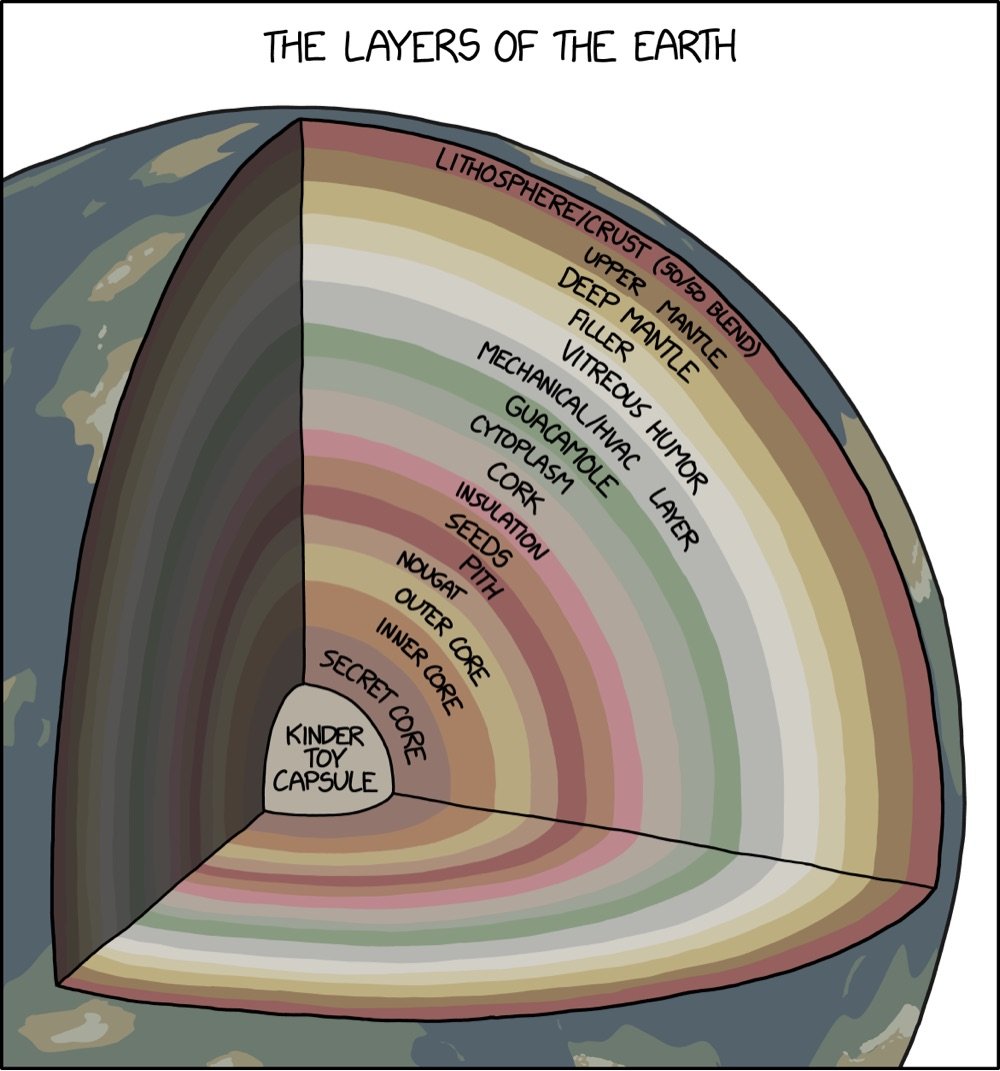
From XKCD, a 3D cutaway map of the many layers of the Earth, from the familiar crust around the outside to the more mysterious layers like nougat, vitreous humor, guacamole, and cork.
Our Frasier Remake
Over 130 animators, actors, filmmakers, and even puppeteers joined forces to remake a 1994 episode of the TV show Frasier called My Coffee With Niles. The episode was split into 185 sections, each 6-12 seconds long, and a different animator or filmmaker took charge of each section. Love this…just an incredible array of styles on display here.
You can read more about the project on their Instagram account. (via @spiritduplicator.bsky.social)
Update: Cartoon Brew has an interview with the project leader about how it all came together.
Taffy Brodesser-Akner profiles Taylor Swift, from the (relatively) cheap seats. “Our only proof that she was actually in the stadium was that the people close to the stage seemed to believe that she was, and we chose to believe them.”
A Manifesto from People Reluctant To Kill for an Abstraction
I ran across this Slate piece by George Saunders yesterday and thought it was worth reposting. (Content warning: this article lists many violent acts, none of which are performed.)
At precisely 9 in the morning, working with focus and stealth, our entire membership succeeded in simultaneously beheading no one. At 10, Phase II began, during which our entire membership did not force a single man to suck another man’s penis. Also, none of us blew himself/herself up in a crowded public place. No civilians were literally turned inside out via our powerful explosives. In addition, at 11, in Phase III, zero (0) planes were flown into buildings.
During Phase IV, just after lunch, we were able to avoid bulldozing a single home. Furthermore, we set, on roads in every city, in every nation in the world, a total of zero (0) roadside bombs which, not being there, did not subsequently explode, killing/maiming a total of nobody. No bombs were dropped, during the lazy afternoon hours, on crowded civilian neighborhoods, from which, it was observed, no post-bomb momentary silences were then heard. These silences were, in all cases, followed by no unimaginable, grief-stricken bellows of rage, and/or frantic imprecations to a deity. No sleeping baby was awakened from an afternoon nap by the sudden collapse and/or bursting into flame of his/her domicile during Phase IV.
It’s a timely reminder of the overwhelming huge number of people in the world who are not militant extremists — but also of the power held by the tiny minority that are.
Six Months Ago NPR Left Twitter. The Effects Have Been Negligible. “The numbers confirm what many of us have long suspected - that Twitter wasn’t worth the effort, at least in terms of traffic.” Yeah, same here. Don’t miss it at all.
The trailer for aka Mr. Chow, a documentary about the legendary restaurateur who has returned to art later in life. Out Oct 22 on HBO.
Launching a New Thing Soon!
Hey all. I’m going to be launching a new thing here soon (more on that in a few days), but you may have already noticed some changes around here. Design tweaks mostly. What you don’t see is that I pretty much ripped out the main guts of the site and rewrote a key piece of it…painful but necessary for some upcoming features. Hooooopefully it’s all working properly, but let me know if you see anything amiss? Especially with the membership stuff?
Anyway, one of the changes that people using RSS/newsreaders to read the site will have noticed is that the Quick Links are no longer bundled up into a few digests/day…they now arrive as they’re posted, one at a time. So if you got a bunch of old Quick Links clogging up your feedreader this morning, sorry about that — it should be a one-time thing.
Also regarding the RSS feed: the QL RSS items do not have titles (they are optional IIRC) and I’m getting a glimpse of the ways in which various newsreaders, uh, deal with title-less items. 😬 I’ve tested Feedly and Feedbin, but if you use another newsreader, would you mind emailing me a screenshot of how it handles these title-less Quick Links? Thanks!
Update: Ok, I’ve got FreshRSS, Newsblur, Unread, Reeder, NetNewsWire, Newsify, Newsboat, Inoreader, The Old Reader, Tiny Tiny RSS, Vienna, and a few others. I think I’m all set, thank you!
Clip of a TV station switching from black & white to a color transmission for the first time in 1967.
Newsstands From Around the World
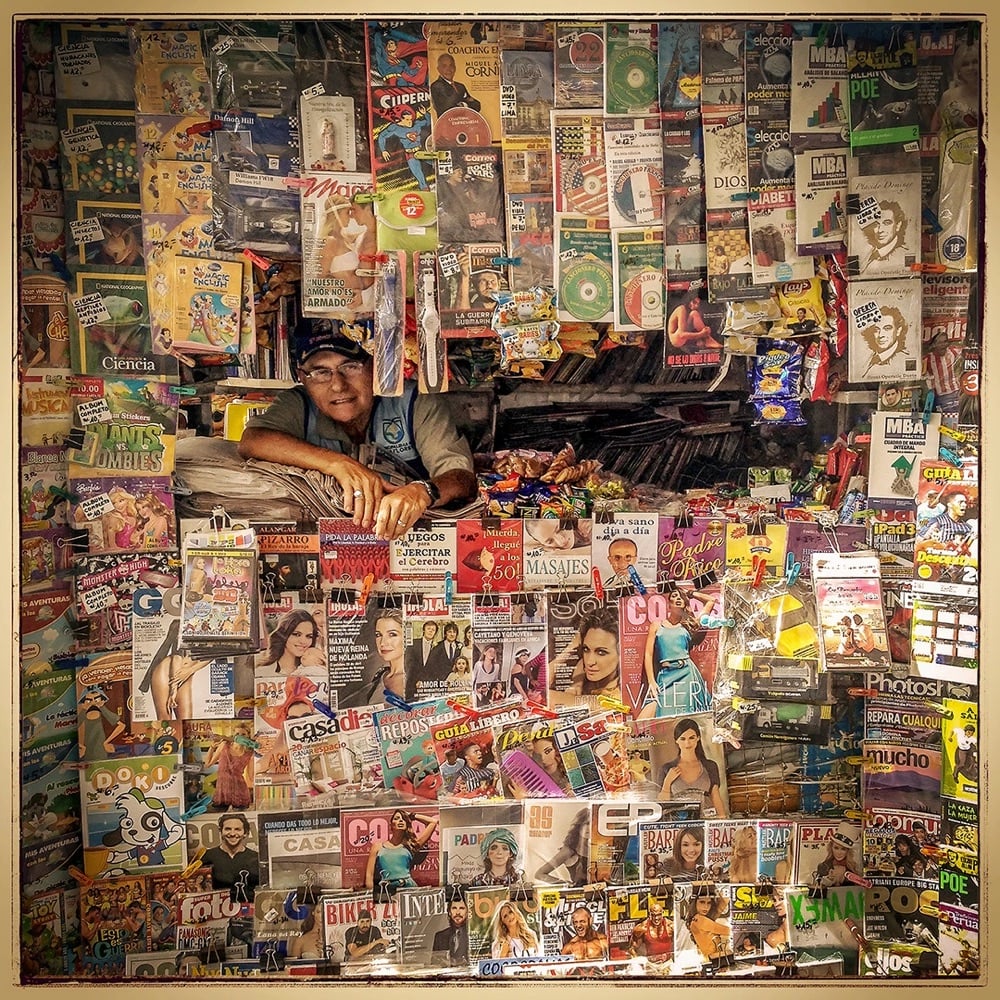

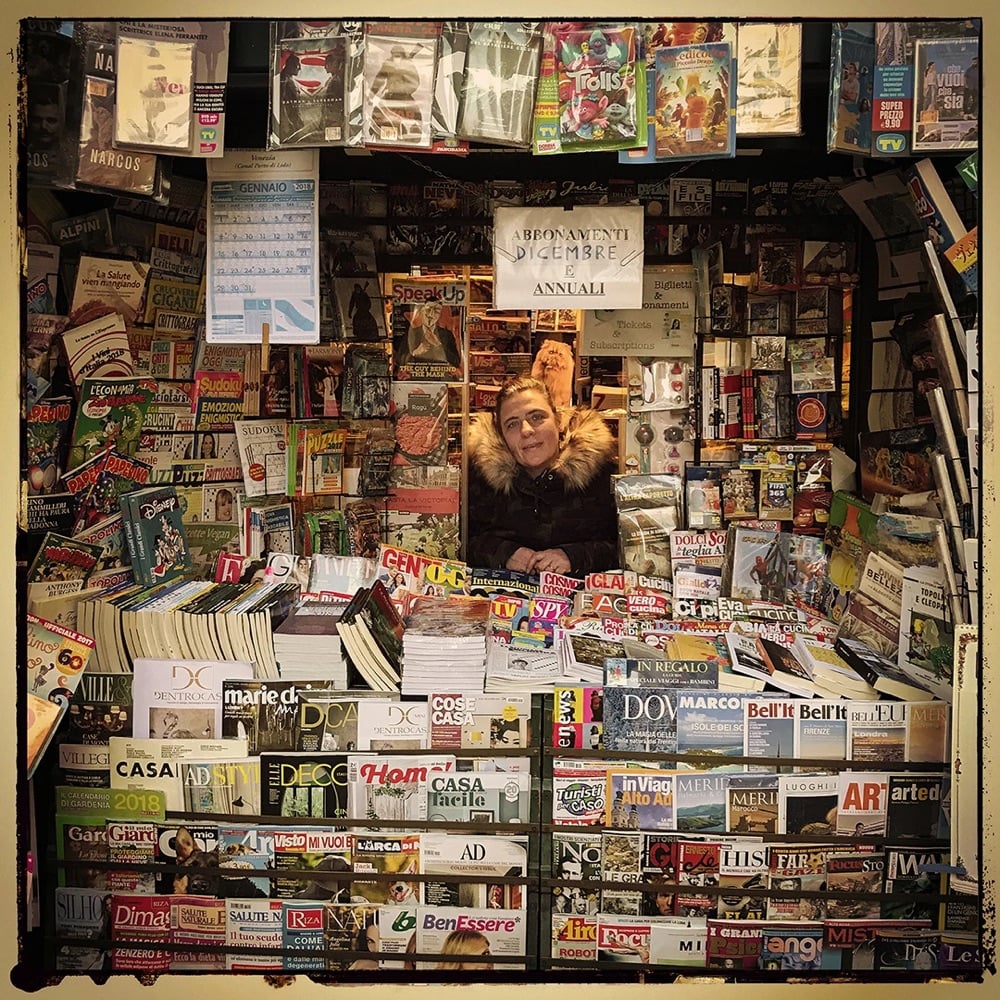
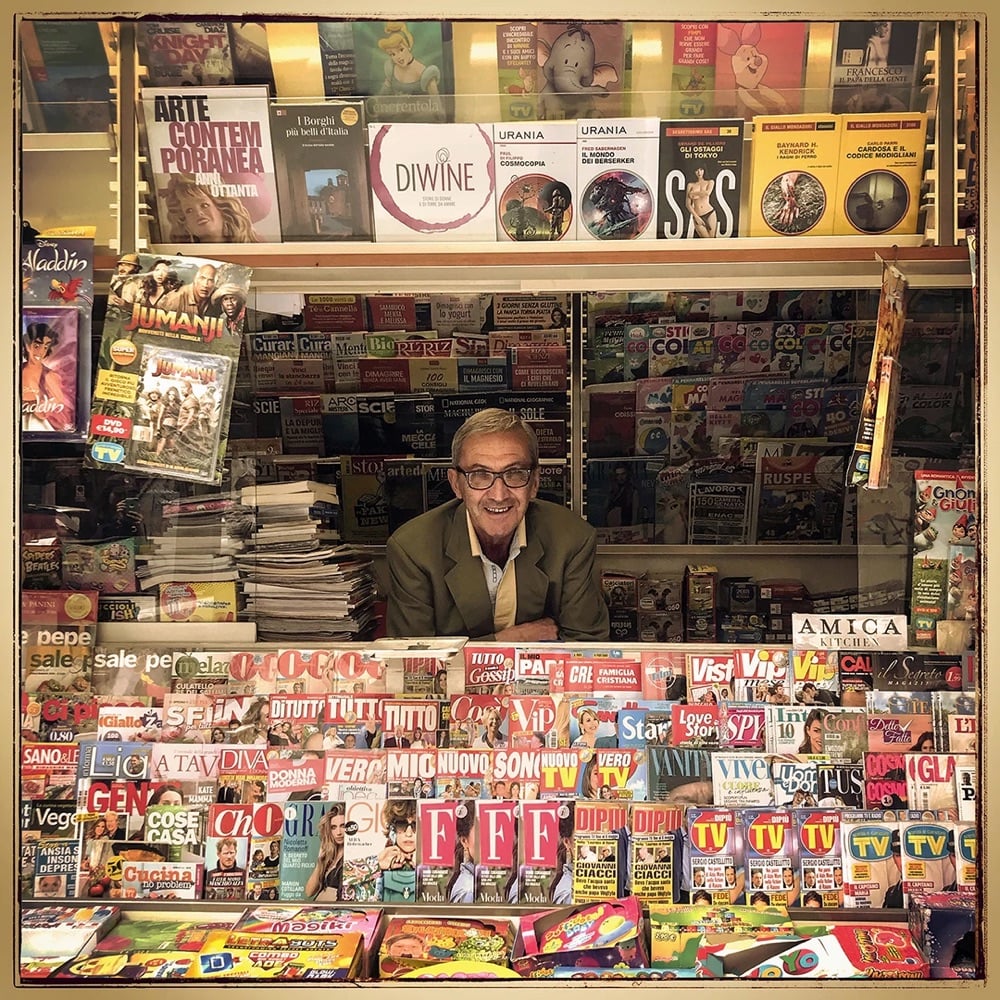
Over a period of eight years, Trevor Traynor took dozens of photos of newsstands and their operators. The project started in NYC but came to include newsstands in LA, Lima, Tokyo, Jerusalem, Marrakesh, London, Rome, Paris, and several other places around the world. (via present & correct)
The turn-of-the-century volcano photography of Tempest Anderson. “You know, Anderson, you are sure to be killed, but it will be such a very great satisfaction to you afterwards to think that it was in the cause of science.”
The Trailer for All the Light We Cannot See
This new series from Netflix looks pretty good — and it’s got an impeccable pedigree: it’s based on Anthony Doerr’s All the Light We Cannot See, a Pulitzer Prize winner, National Book Award finalist, and a bestseller to boot. The four-part limited series premieres November 2nd.
What Americans Know About Religion, a Pew Research survey from 2019. Atheists and agnostics tend to know more about religion than Christians do.
The climate crisis has cost $16 million per hour in extreme weather damage over the past 20 years. That’s $2.8 trillion total…likely “a significant understatement”. And it’s only going to get worse.
How Red-State Politics Are Shaving Years Off American Lives. “[State-level] investments began to diverge sharply along red and blue lines, with conservative lawmakers often balking at public health initiatives they said cost too much or overstepped.”
US citizens or permanent residents with permanent disabilities can get a free lifetime pass to US National Parks (and other federal lands).
Yo-Yo Ma plays Bach’s Cello Suite No. 1 in the Great Smoky Mountains
You have likely heard Yo-Yo Ma play his most famous piece before. Maybe even dozens of times. But Ma’s rendition of Bach’s Cello Suite No. 1 takes on a whole new dimension when accompanied by a babbling brook and bird calls in the forests of the Great Smoky Mountains. A lovely moment of peace in a world that could really use some right now.
During a recent show, Jerry Seinfeld seemed to tease the return of Seinfeld: “something is going to happen that has to do with that ending”.
Prada is helping design the spacesuits the astronauts will wear on NASA’s Artemis III mission that’s schedule to land on the Moon in 2025.
From the Milwaukee Public Library’s meme-tacular Instagram account: trying to read as a kid in America.
The Inner Landscape

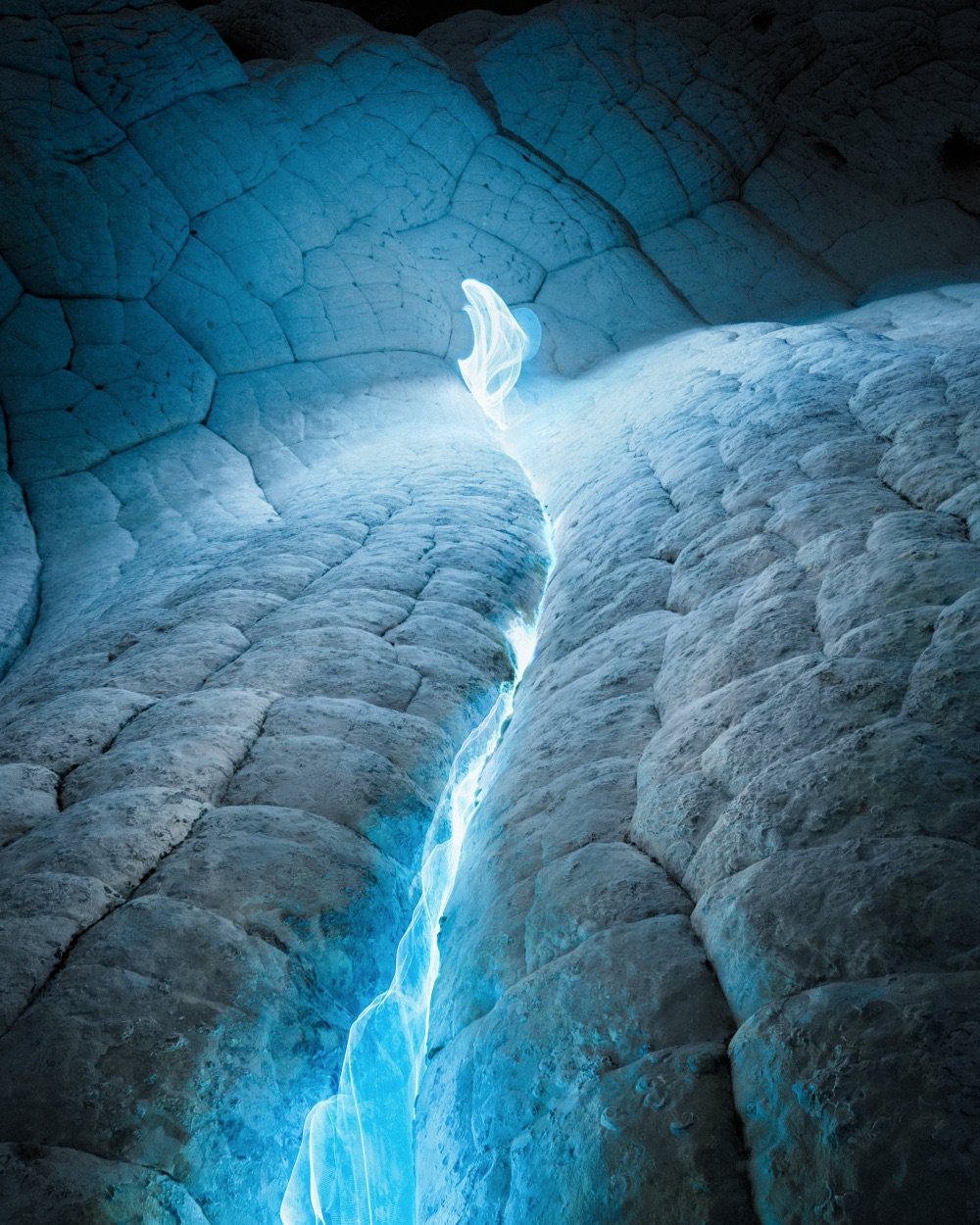

Photographer Reuben Wu was commissioned by Apple to take some of his wonderful light-painted photos with Apple iPhone 15 Pro Max in a project called The Inner Landscape.
So proud to be one of the first photographers to reveal a new series of images captured on the Apple iPhone 15 Pro Max and celebrate its launch. “The Inner Landscape” is a series of six unearthly places that feel more intimate than epic, more ambiguous than explicit, making up a body of work that feels cohesive through its sense of connection and psychological space.
I love Wu’s work. More information about this project can be found at Colossal, Petapixel, and on Wu’s Instagram.
‘What Is Broken in American Politics Is the Republican Party’. “A grown-up Republican Party — even a deeply conservative one — would accept the rule of law, the norms of liberal democracy, and the legitimacy of the opposing party.”
It’s Random Early Fall Shopping Day!
Amazon has a bunch of stuff on sale today & tomorrow for an “event” they’re calling Prime Big Deal Days. I’m not going to do a big roundup here, but here are a few things you might be interested in if you’re an Amazon shopper:
- Apple AirPods Pro (2nd Gen) with Lightning connector for $189 (24% off). This is the lowest price I’ve seen on these; they’re the best headphones I’ve ever owned. Apple just released a newer version of these (nearly the same product except for a USB-C connector on the case) and the low price is probably to clear out inventory. Both versions charge just fine with a MagSafe or Qi-certified charger, so why not get the cheaper one if you charge that way and don’t care about the small differences? Update: Both versions are the same price (I don’t think they were this morning). So get the newer ones!
- Apple 2020 MacBook Air Laptop M1 for $750 (25% off). This is my laptop. I love this laptop. When my daughter needed a new computer for high school, I bought her one of these.
- Amazon Kindle Paperwhite for $95 (32% off). I read all my books on this. Lightweight and the battery lasts forever. And it charges with USB-3 so that’s one less cable to haul around.
- SAF Aranet4 Home CO2 Monitor for $159 (36% off). This is everyone’s pick for the best indoor air quality monitor.
- Splendor Board Game for $20.49 (54% off). This has been a recent hit around our house…very easy to play but still difficult to master.
- KitchenAid 3.5 Qt. Stand Mixer for $260 (32% off). This is KitchenAid’s smaller stand mixer, which is lighter and takes up less counter space in smaller kitchens.
You can find more deals on the Prime Big Deal Days page.
When you buy through links on kottke.org, I may earn an affiliate commission. Thanks for supporting the site!
Scholastic Under Fire for Allowing Schools to Opt Out of ‘Diverse Books’ for Book Fairs. “Why is it appropriate for Scholastic to have an easy censorship option?”
Coming Soon: Planet Earth III
Planet Earth III will begin airing later this year on BBC and, presumably, at some later time in the US. The latest installment in the legendary series, 17 years after the first one was released, will once again be presented by Sir David Attenborough, now 97 years old and still as enthusiastic about sharing the wonders of nature as he ever was.
‘The opening of the series with David was filmed in the beautiful British countryside in exactly the location where Charles Darwin used to walk whilst thinking-over his Earth-shaking ideas about evolution. It seemed the perfect place for David to introduce Planet Earth III and remind us of both the wonders and the fragility of our planet. ….and for him, of course, the sun shined under blue skies one of the only days it did all summer!.’
The video above is a quick first look at the series and here’s a trailer as well:
Looking forward to this…the Planet Earth series is still the gold standard for nature documentaries.
An Epidemic of Chronic Illness Is Killing Us Too Soon. “The United States is failing at a fundamental mission — keeping people alive.”
Michael Lewis finds himself under the microscope. “What happens when a writer who is used to rapturous reception, with a knack for shaping stories, collides with an active public drama he doesn’t control?”
Errol Morris Did Not Like This Q&A About His le Carré Film. “Properly considered, no one should ever under any circumstances talk to anybody else.”
Kelvin Kiptum shatters marathon world record with run of just over two hours. Wow, 2:00:35. “As the 23-year-old ran the final few hundred metres along Columbus Drive, he even had time to blow kisses and wave to the crowd.”
It’s Decorative Gourd Season, Motherfuckers. “I don’t know about you, but I can’t wait to get my hands on some fucking gourds and arrange them in a horn-shaped basket…”
Is food in America better or worse than in other countries (France, Korea, Peru) around the world? It depends on what you mean by “better” and how broad your lens is.
A preview of Spike Lee: Creative Sources, up at the Brooklyn Museum through early February. “There are so many amazing objects in his collection, and so many things that are so important to him and that really tell a story.”
Some of the Most Interesting and Weird Manuals in the Internet Archive

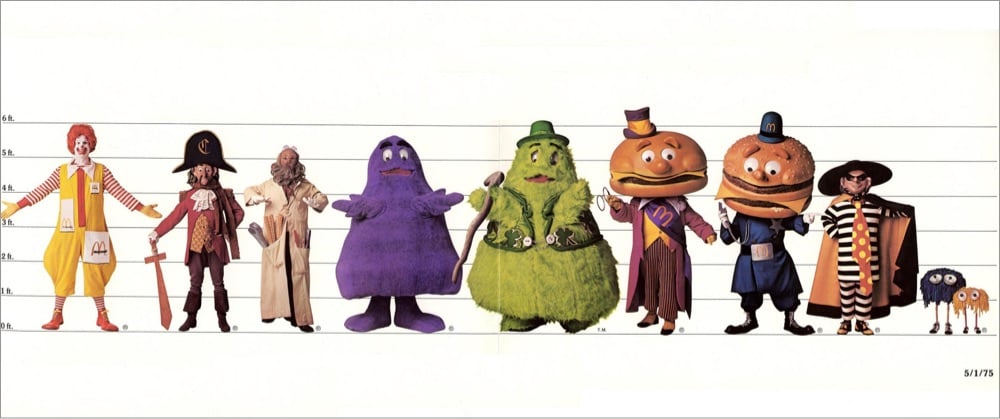
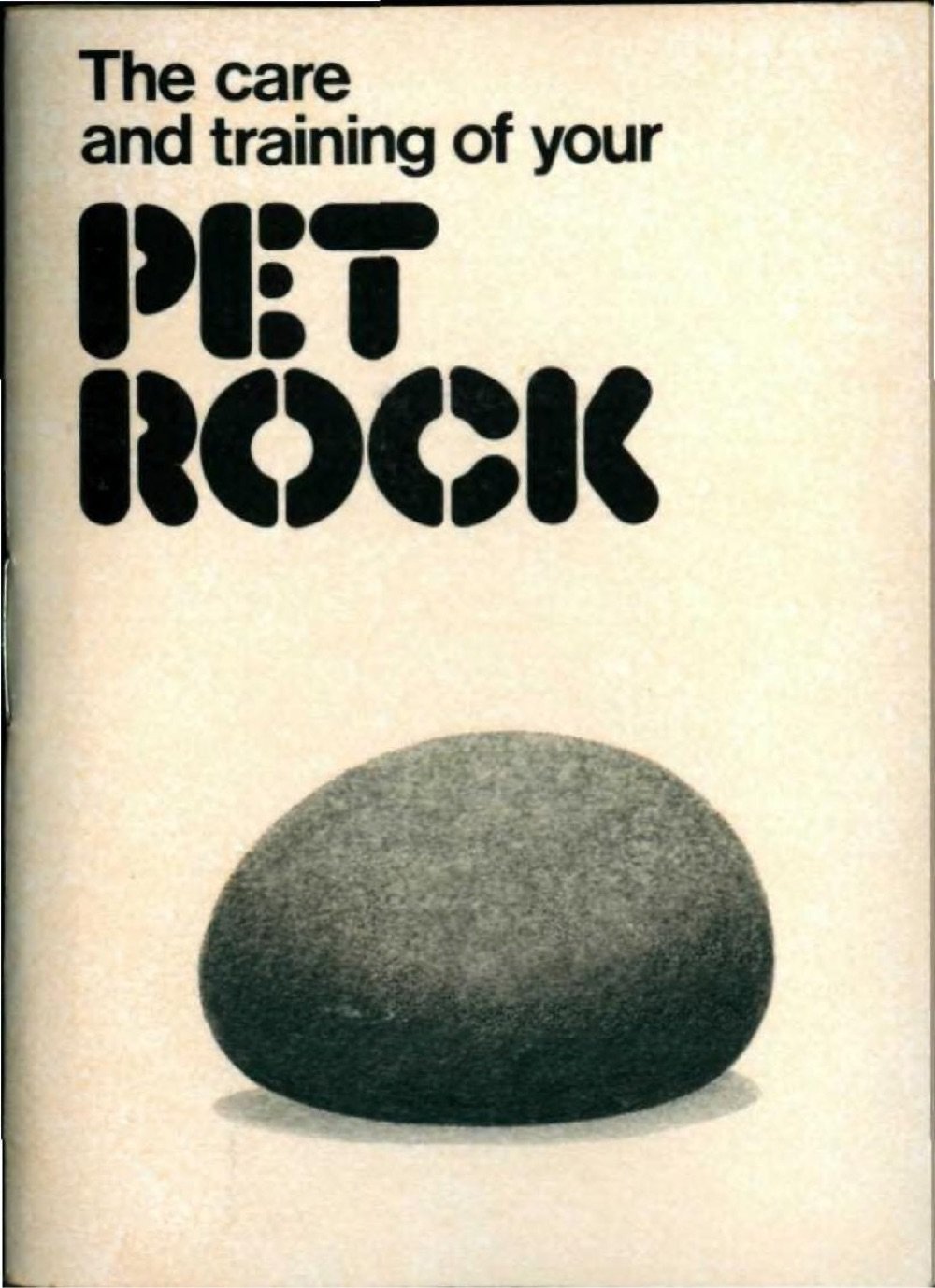
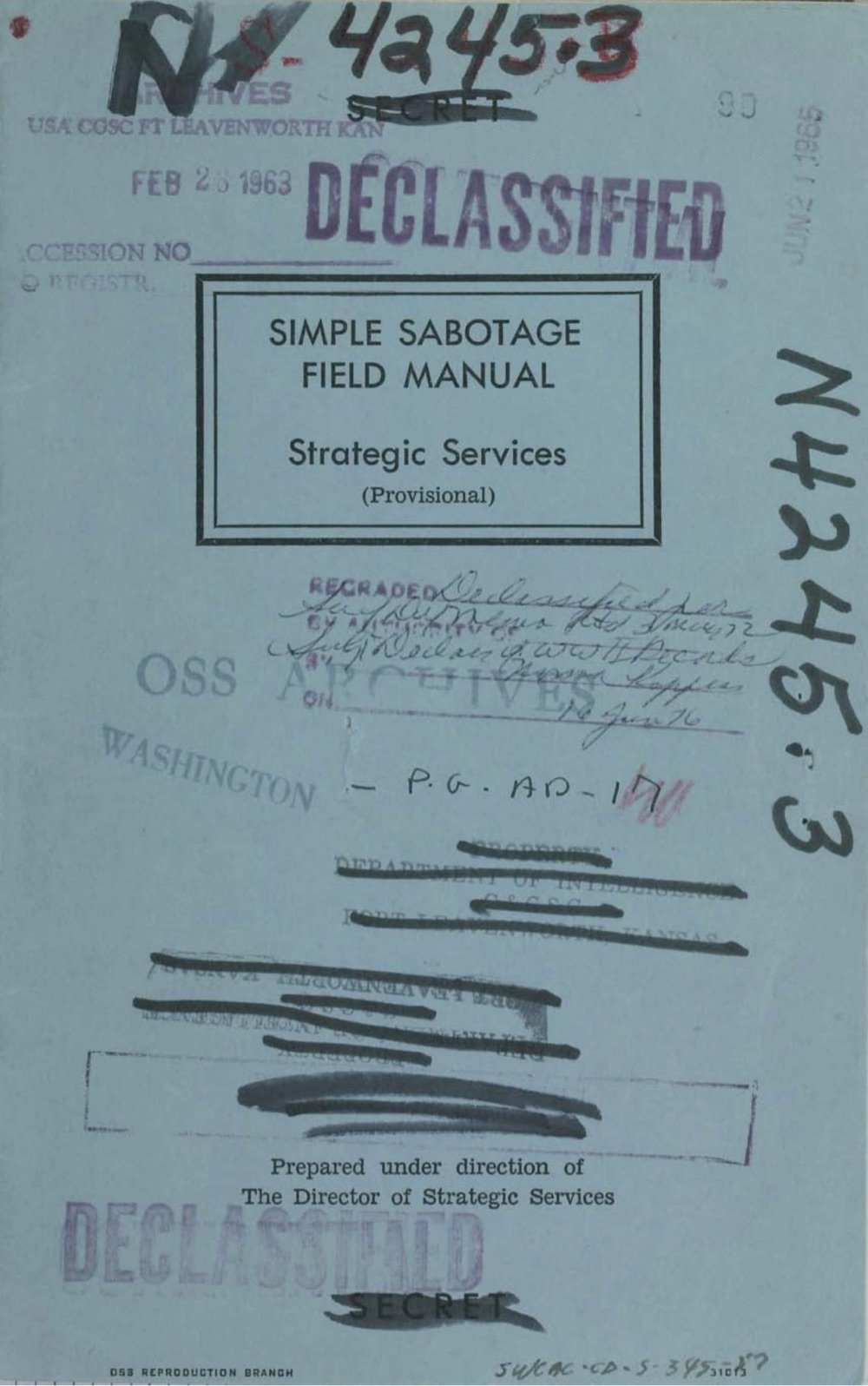
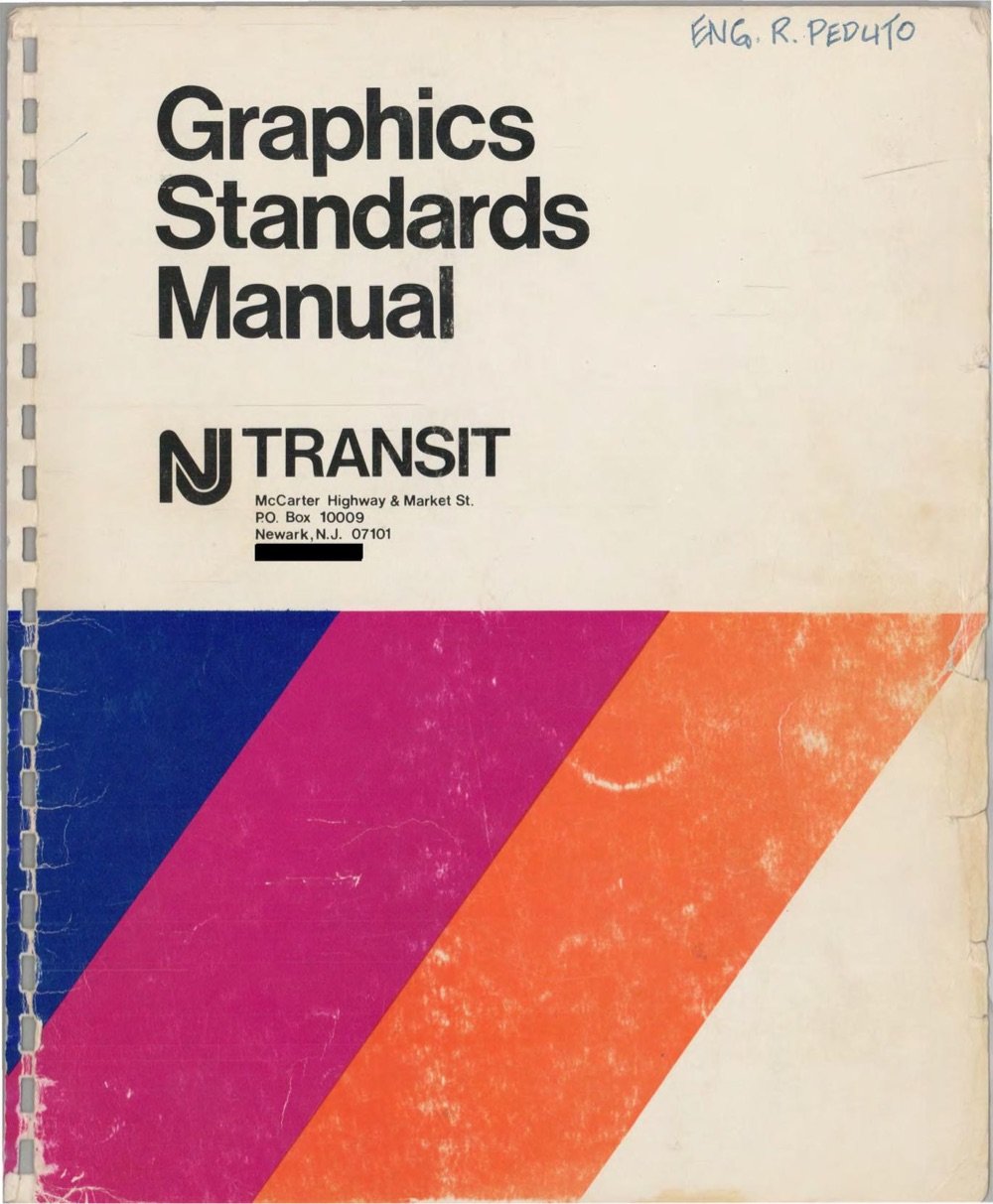
One could spend several hours delving into the Manuals Showcase over at the Internet Archive. Among the collection of handbooks, manuals, and guides, you’ll find gems like the IBM Model B Electric Typewriter User Manual 1954, The Care and Training of Your Pet Rock, CIA Simple Sabotage Field Manual, NJ Transit Graphics Standards Manual, and the McDonalds McDonaldland Specification Manual (1975).
I’ve written about the CIA Simple Sabotage Field Manual before — “some of these things are practically best practices in American business, not against enemies but against their employees, customers, and themselves”.
A Chance Discovery Uncovered the Remarkable Life of One of the First Female Oceanographers, Christine Essenberg. “How many other unknown women in science are out there, hidden away in boxes?”
Vaccines: “The Greatest Benefit Conferred on Humankind”
From The Economist on the occasion of the award of the Nobel Prize for Medicine to Katalin Karikó and Drew Weissman for their work that led to the development of the Covid-19 mRNA vaccines, a lovely short appreciation of vaccines.
The World Health Organisation (WHO) says that vaccines have saved more from death than any other medical invention. It is a hard claim to gainsay. Vaccines protect people from disease cheaply, reliably and in remarkable numbers. And their capacity to do so continues to grow. In 2021 the who approved a first vaccine against malaria; this week it approved a second.
Vaccines are not only immensely useful; they also embody something beautifully human in their combination of care and communication. Vaccines do not trick the immune system, as is sometimes said; they educate and train it. As a resource of good public health, they allow doctors to whisper words of warning into the cells of their patients. In an age short of trust, this intimacy between government policy and an individual’s immune system is easily misconstrued as a threat. But vaccines are not conspiracies or tools of control: they are molecular loving-kindness.
The WHO says that vaccines currently prevent 4-5 million deaths per year. The CDC points to a paper that says that more than 50 million death can be prevented between 2021 and 2030. Vaccination is nothing short of a scientific miracle. (via eric topol)
Critics for The Hollywood Reporter pick their 50 best TV shows of the 21st century (so far). Lots to disagree with here but also “any title [on the list] you had yet to see was surely worth checking out”. And wow, Mad Men.
In iOS 17, users no longer have to include “Hey” when invoking Siri. Siri Price has had to change her name bc every time someone spoke to her, all in-range phones would pipe up. “Now people can’t even say my name. I’m absolutely fuming.”
Huh. Did Medium “borrow” their current logo from Japan Tobacco Inc.’s 1985 logo? They are very similar…
America Is Quickly Becoming More Nonreligious
The Associated Press-NORC Center for Public Affairs Research recently conducted a poll asking Americans about their religious beliefs and found that about 30% of American adults are non-religious (which they refer to as “the nones”, presumably after the book by Ryan Burge).
The decades-long rise of the nones — a diverse, hard-to-summarize group — is one of the most talked about phenomena in U.S. religion. They are reshaping America’s religious landscape as we know it.
In U.S. religion today, “the most important story without a shadow of a doubt is the unbelievable rise in the share of Americans who are nonreligious,” said Ryan Burge, a political science professor at Eastern Illinois University and author of “The Nones,” a book on the phenomenon.
The nones account for a large portion of Americans, as shown by the 30% of U.S. adults who claim no religious affiliation in a survey by The Associated Press-NORC Center for Public Affairs Research.
Other major surveys say the nones have been steadily increasing for as long as three decades.
So who are they?
They’re the atheists, the agnostics, the “nothing in particular.” They’re the “spiritual but not religious,” and those who are neither or both. They span class, gender, age, race and ethnicity.
While the nones’ vast diversity splinters them into myriad subgroups, most of them have this in common:
They. Really. Don’t. Like. Organized. Religion.
But a dislike of organized religion among the nonreligious doesn’t necessarily translate into atheism or agnosticism: 43% of “the nones” say they believe in God.
The MacArthur Foundation has announced 2023’s round of fellows and accompanying $800,000 “genius grants”. Aw shoot, passed over again!
Last month was the hottest September on record by an “absolutely gobsmackingly bananas” margin. “September 2023 beat the previous record for that month by 0.5C, the largest jump in temperature ever seen.” 1.8C warmer than pre-industrial levels.
Every Type of Railcar Explained in 15 Minutes
This video from Practical Engineering offers a brief explanation of dozens of different types of railcars, from passenger train cars like the dining car & sleeper car to freight cars like the boxcar, tank car, and hopper cars (for hauling things like sand or grain) to specialized cars the rail companies use to build and maintain their routes like rail grinders, snowplows, and track geometry cars.
Trains are one of the most fascinating engineered systems in the world, and they’re out there, right in the open for anyone to have a look! Once you start paying attention, its pretty satisfying to look for all the different types of railcars that show up on the tracks.
They even made a little checklist to use for your beginner trainspotting. (via the kid should see this)
“Lise Meitner developed the theory of nuclear fission, the process that enabled the atomic bomb. But her identity — Jewish and a woman — barred her from sharing credit for the discovery, newly translated letters show.”
One Revolution Per Minute
Erik Wernquist made his short film One Revolution Per Minute to explore his “fascination with artificial gravity in space”. The film shows what it would be like to travel on a large, circular space station, 900 meters (0.56 miles) in diameter that rotates a 1 rpm. Even at that slow speed, which generates 0.5 g at the outermost shell, I was surprised to see how quickly the scenery (aka the Earth, Moon, etc.) was rotating and how disorienting it would be as a passenger.
Realistically - and admittedly somewhat reluctantly — I assume that while building a structure like this is very much possible, it would be quite impractical for human passengers.
Putting aside the perhaps most obvious problem with those wide windows being a security hazard, I believe that the perpetually spinning views would be extremely nauseating for most humans, even for short visits. Even worse, I suspect — when it comes to the comfort of the experience — would be the constantly moving light and shadows from the sun.
I calculated that the outer ring of the space station is moving at 105.4 mph with respect to the center. That’s motoring right along — no wonder everything outside is spinning so quickly.
The Hidden Costs of Using an Electric Bike. “An electric bike is going to force you to get a lot more fresh air than you’re used to.” Lolz.
Making It So, a Memoir by “Severe Bastard” Patrick Stewart
Fall always brings brisker days, earlier sunsets, and a whole raft of new books that are impossible to find the time to read. Add this memoir by Patrick Stewart to the pile next to your bed: Making It So (bookshop.org). The Hollywood Reporter has a great video excerpt with audio from the audiobook (narrated by Stewart himself, naturally) about his early days on Star Trek: The Next Generation:
From an accompanying article:
So when he was on set shooting the show’s debut season and co-stars like Jonathan Frakes, Denise Crosby and Brent Spiner would tease him or ad-lib a joke or laugh when they flubbed their lines, it would low-key infuriate him.
“I could be a severe bastard,” he writes. “My experiences at the Royal Shakespeare Company and the National Theatre had been intense and serious… On the TNG set, I grew angry with the conduct of my peers, and that’s when I called that meeting in which I lectured the cast for goofing off and responded to Denise Crosby’s, ‘We’ve got to have some fun sometimes, Patrick’ comment by saying, ‘We are not here, Denise, to have fun.’”
“In retrospect,” Stewart continues, “everyone, me included, finds this story hilarious. But in the moment, when the cast erupted in hysterics at my pompous declaration, I didn’t handle it well. I didn’t enjoy being laughed at. I stormed off the set and into my trailer, slamming the door.”
Update: Gideon Lichfield has a great interview with Stewart for Wired.
Q: There’s a passage where you say that, from your father, “I drew Picard’s stern, intimidating tendencies. But I like to think that my mother is in the captain too, in his moments of warmth and sensitivity.” Do you see Picard as your way of reconciling that conflict between your parents?
A: Very much so, yes. Both Star Trek and therapy have been responsible for that. Having to open the doors into my childhood in order to be an actor became utterly intriguing to me in a way that it never had been before. And I regret that when I look back on some of the roles I played, what I might have brought to them if I just released myself a little bit more.
(via @samuelwade)
Shohei Ohtani’s Impossible, Unrivaled, Bittersweet Season. “It might have been the greatest year of individual achievement in major-league history. Will we ever see anything like it again?”
Several years ago, great white sharks suddenly started disappearing from their traditional habitats in South Africa. Scientists have finally figured out why. “Lots of people weren’t used to thinking of great white sharks as prey.”
Martin Scorsese Breaks Down His Most Iconic Films
This is a treat: almost 25 minutes of legendary director Martin Scorsese talking about how he made his most iconic movies, from Mean Streets and Raging Bull to Gangs of New York and The Irishman. You have to laugh at the number of times he says, “Well, I didn’t want to make this film, but…” From an accompanying profile/interview with Scorsese (which is quite good as well):
It is a peculiar fact about Martin Scorsese that he does not enjoy actually making movies. “I don’t mean to be funny,” he said, “but, the thing is, you get up real early.” And Scorsese has never been a morning person. For most of his life, he recalled, “I’d stay up late watching movies on TV or reading late, or doing homework late, or trying to write scripts late. I lived at night and the streets were dark, and I never saw the light. It took me many years to understand where the sun set and where the sun rose. I didn’t know. I’m not kidding. I learned it in LA. When you’re going on Sunset Boulevard and you hit the Pacific Coast Highway and it’s seven o’clock and the sun is setting — it’s right there.”
He likes to borrow a complaint from Kubrick. “They said, ‘What’s the hardest thing about directing?’ He said, ‘Getting out of the car.’ Because once you get out of the car, the questions start.” Now, when Scorsese gets out of the car in the morning, he looks at his AD and says, “What can’t I have today?”
The teaser trailer for season 2 of The Gilded Age, which premieres on HBO at the end of October. (Yeah, I’m just not going to call it “Max”.)
Supercut of Songs That Stop on the Word “Stop”
You really have to applaud the effort here: YouTuber Todd in the Shadows made a 33-minutes supercut of every song he could find that stops, even momentarily, on the word “stop”. Here are the ground rules:
If there was even the briefest of stops, I counted it. It’s okay if the band holds the note rather than complete silence. But the entire band has to stop, not just a couple instruments; the singer can keep singing though.
I gotta say I did not watch the whole thing, but the very last clip is *kisses fingers*. (via @peterme)
Out today: Going Infinite, Michael Lewis’s book on crypto and Sam Bankman-Fried (whose trial starts today). Lewis’s mini-season of interviews for the book on his Against the Rules podcast was really interesting.
NASA is planning to build long-term housing on the Moon using 3-D printing and soil made out of moon dust. “They believe that by 2040, Americans will have their first subdivision in space.”
Notable Sandwiches. Talia Lavin is “going through Wikipedia’s List of Notable Sandwiches in alphabetical order” and providing some “tasty commentary” about them.
Google Changes Search Queries Without Telling You (to Sell You More Stuff)
Megan Gray on a disturbing piece of information that was revealed in the antitrust case against Google: their search engine replaces some search queries with others that generate more commercial results (and therefore more money for the company). Here’s how it works:
Google likely alters queries billions of times a day in trillions of different variations. Here’s how it works. Say you search for “children’s clothing.” Google converts it, without your knowledge, to a search for “NIKOLAI-brand kidswear,” making a behind-the-scenes substitution of your actual query with a different query that just happens to generate more money for the company, and will generate results you weren’t searching for at all. It’s not possible for you to opt out of the substitution. If you don’t get the results you want, and you try to refine your query, you are wasting your time. This is a twisted shopping mall you can’t escape.
Yuuuck. I think it might be time to switch away from Google search — its results have been getting worse for years and it seems like the company doesn’t care too much about fixing it. I’ve been hearing good things about Kagi and there’s always DuckDuckGo.
Update: Several people wrote in noting that Gray’s article was an opinion piece, not reported, and that there was no corroboration of her claim of Google’s query switcheroo. For their part, Google denies the claim: Per Platformer:
Google does not delete queries and replace them with ones that monetize better as the opinion piece suggests, and the organic results you see in Search are not affected by our ads systems.
(thx, andy)
Update: Wired has removed the story from their website:
After careful review of the op-ed, “How Google Alters Search Queries to Get at Your Wallet,” and relevant material provided to us following its publication, WIRED editorial leadership has determined that the story does not meet our editorial standards. It has been removed.
The Internet Archive has a copy of the original piece. Charlie Warzel has more in a report from the Atlantic. (thx, andy)
The Cody Dock Rolling Bridge
Designed by architect Thomas Randall-Page, the Cody Dock rolling footbridge opens with a “surprising and playful motion” to let boats pass through by simply rolling out of the way.
The bridge rolls on undulating rails cast into the concrete abutments on either bank. Ballast fills the top of each square portal, countering the weight of the bridge deck that connects them. This symmetry allows the whole bridge structure to smoothly role through 180 degrees to a fully inverted position facilitating movement of boats from the river to the dock. This finely balanced is this system allows the 13 tonne bridge to be operated via hand winches only.
Here’s a video about the then-proposed bridge from 2019 that shows the unique rolling mechanism:
And here’s a video from earlier this year that shows the design process and how the finished bridge works:
On Luddites, the rebellion against Big Tech, human rights, and the AI threat: “Robots aren’t coming for your job; bosses are.” Ted Chiang: “Most fears about A.I. are best understood as fears about capitalism.”
Katalin Karikó just won the Nobel Prize for her dogged and live-saving work on mRNA vaccines. Her impeccably timed memoir, Breaking Through: My Life in Science, is coming out next week.
Blaring phones will scare the beejesus out of everyone in America on Oct 4 at 2:20pm ET; FEMA is conducting a test of their public alert system. Maybe set an alarm or calendar notification so you’ll be prepared?
“A cheap malaria vaccine that can be produced on a massive scale has been recommended for use by the World Health Organization (WHO).” Each dose is only $2-4 (4 doses/person) and 100 million doses/yr are already lined up to be produced.
How the Elon Musk biography exposes Walter Isaacson. “We are dealing with not one but two unreliable narrators: Musk and Isaacson himself.”
Using NLP to find similar phrases to “champagne for my real friends, real pain for my sham friends”. Results included “focus for my real friends, real cuss for my faux friends” and “metrics for my real friends, real tricks for my meh friends”.
A Family of Humming-Birds
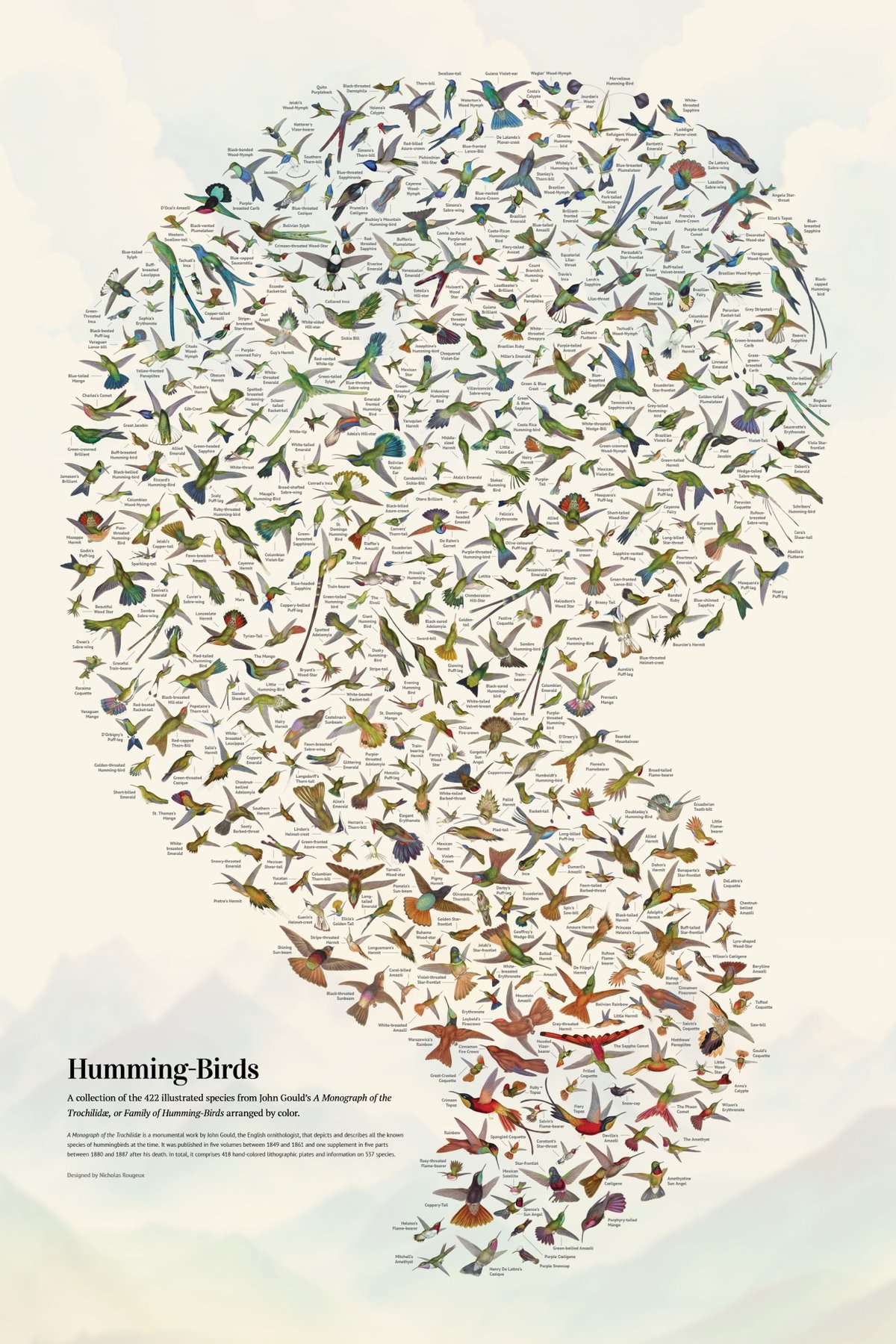
Wow, Nicholas Rougeux has restored John Gould’s A Monograph of the Trochilidæ, or Family of Humming-Birds, which was published between 1848 & 1887 and contains hand-colored lithographic depictions of almost every single hummingbird species known to exist at the time.



From Rougeux’s page about the project:
The monograph is considered one of the finest examples of ornithological illustration ever produced, as well as a scientific masterpiece. Gould’s passion for hummingbirds led him to travel to various parts of the world, such as North America, Brazil, Colombia, Ecuador, and Peru, to observe and collect specimens. He also received many specimens from other naturalists and collectors.
The image at the top of the post is the gorgeous poster that Rougeux created from the drawings in Gould’s monograph…you can order some for your walls and read a making-of.
The new words added to the Merriam-Webster dictionary last month include rizz, cromulent, vector graphics, rewild, jorts, non-player character, jump scare, finsta, beast mode, and thirst trap.
UNESCO Just Named 42 New World Heritage Sites. “Among the newly inscribed group are an archaeological cemetery site in South Korea, a roadside inn in Iran, and a famed hop-growing region in Czechia.”
Why Henry VIII’s Codpiece Is So…Monumental
Perhaps the most prominent part of the most well-known painting of Henry VIII (a now-lost work by Hans Holbein the Younger) is the giant codpiece poking through the male-heirless king’s tunic. Evan Puschak analyzes the painting and fills us in on what makes this a particularly effective work of 16th-century propaganda.
Puschak had some fun with this one…I lol’d at “triple dick”, which under no circumstances should you google (like I did) at work or really anywhere else. Although, “triple dick art history” did lead me to this interesting piece on “ostentatio genitalium”:
Ostentatio genitalium (the display of the genitals) refers to disparate traditions in Renaissance visual culture of attributing formal, thematic, and theological significance to the penis of Jesus.
This bit got me laughing again:
…these Renaissance images shock us because they are so frequently ithyphallic: Christ has risen, but not in the way we have come to expect.
Thomas Zimmer on one of my political pet peeves: the polarization narrative. “The ‘polarization’ paradigm privileges unity, stability, and social cohesion over social justice and equal participation.”
Hayao Miyazaki Announces Return To Filmmaking After Big Time Fuckup At New HVAC Installation Job. “They had to bring in the drywall crew to repair all the damage I caused.”
Using AI voice-cloning to make pop stars cover Weird Al Yankovic songs instead of the other way around. Think Michael Jackson covering Eat It and Madonna singing Like A Surgeon.
Why Rappers Stopped Writing
These days, instead of writing down lyrics and bringing them to the studio to record, many rappers are using the improvisational “punch-in method” to craft songs during the recording session.
Is this good for the music? The jury is out, even within hip-hop. But in this behind-the-scenes video — the latest entry in our Diary of a Song series, which documents how popular music is created — we track the generational shift through exclusive studio footage of young rappers like Doechii, Veeze and Lil Gotit, plus interviews with genre veterans including the artist Killer Mike and the producer Just Blaze, to track this creative shift and its effects on the still-experimental genre of hip-hop, 50 years after its birth.
Interesting technique, but there is definitely some music in that video that is not for me.
The 2023 Nobel Prize in Physiology or Medicine has been awarded to Katalin Karikó and Drew Weissman “for their discoveries concerning nucleoside base modifications that enabled the development of effective mRNA vaccines against COVID-19”.




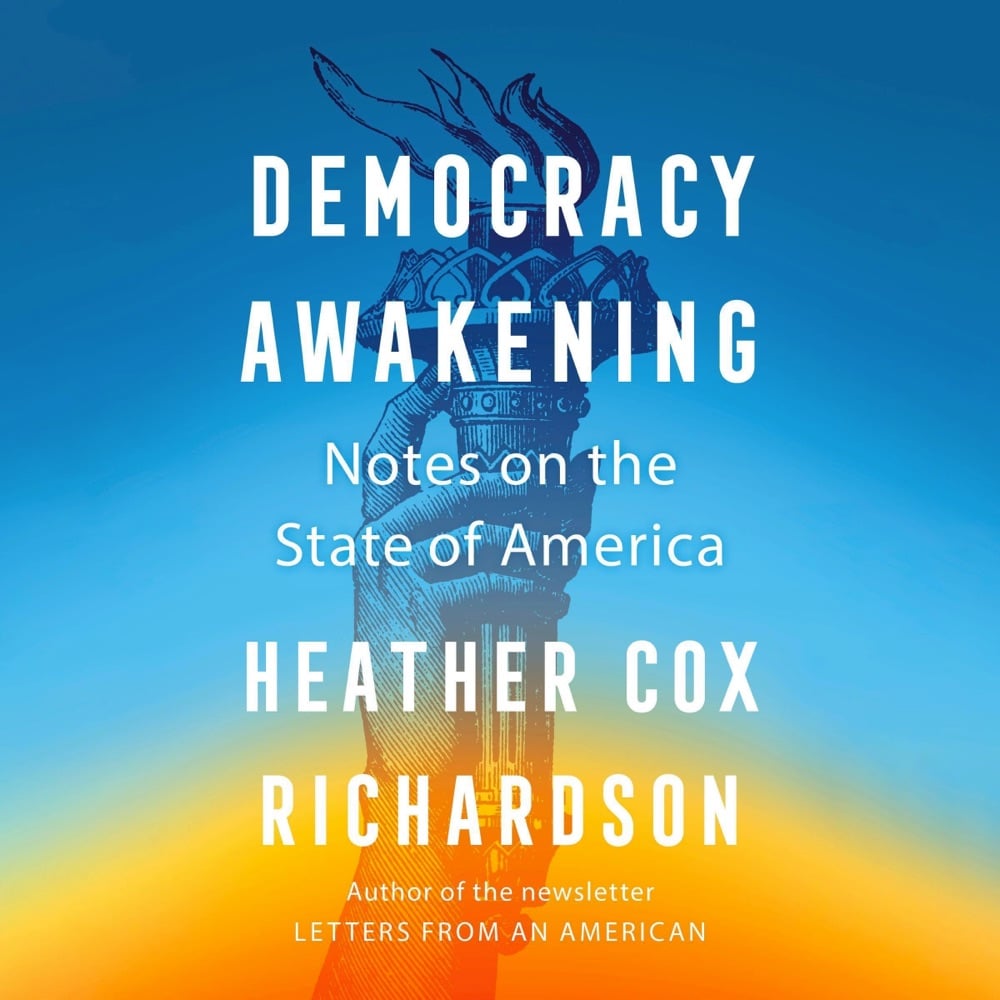
Stay Connected